
Rick Tischaefer
Biological Science Technician
USDA-APHIS-Wildlife Services
Bismarck, North Dakota
Human-Wildlife Conflicts
The coyote (Canis latrans; Figure 1) is a
medium-sized member of the canid family.
Once primarily found in western deserts
and grasslands, coyotes have expanded
their range across North America and into
diverse habitats, including urban areas.
This expansion occurred during a time of
extensive habitat change and efforts by
people to suppress coyote populations to
prevent damage.
Coyotes can cause a variety of conflicts
related to agriculture, natural resources,
property, and human health and safety.
This document highlights a variety of
methods for reducing those conflicts.
Coyotes are a highly adaptable species
and may become habituated to some
management tools and techniques used to
reduce or prevent damage.
Wildlife Damage Management
Technical Series
U.S. Department of Agriculture
Animal & Plant Health Inspection Service
Wildlife Services
November 2020
Coyotes
Figure 1. Coyote
(Canis latrans).
Quick Links
Human-Wildlife Conflicts 1
Damage Identification 2
Management Methods 4
Economics 21
Species Overview 22
Legal Status 26
Glossary & Key Words 28
Resources 29
Appendices 32

Agriculture and Livestock
Coyotes are omnivores (i.e., eat plants and animals) and
pose substantial threats to agricultural crops and
livestock. They forage on agricultural crops, such as
watermelons, sweet corn, and berries. Coyote
depredation on poultry and livestock (e.g., sheep,
cattle, goats), and non-traditional livestock and
specialty breeds (e.g., miniature horses, donkeys,
game birds, rabbits) is frequently a concern when
both share the same environment. Furthermore,
coyotes may spread the parasite Neospora caninum
to livestock, causing abortion and neonatal mortality
in cattle.
Human Health and Safety
Where coyotes occur near people, they sometimes
become acclimated to human presence (Figure 2).
Coyotes may attack and kill pets, other domestic
animals, and sometimes threaten or attack people.
Additionally, coyotes pose aviation hazards when they
occur on airports. In fact, coyotes are one of the
terrestrial mammals most frequently struck by airplanes
according to the Federal Aviation Administration’s
National Wildlife Strike Database, 1990-2018.
Coyotes can carry transmissible diseases and parasites, such
as rabies and Echinococcus granulosus tapeworms, which
may threaten human health and safety.
Natural Resources
Coyote predation can impact the recovery of threatened
and endangered species, such as black-footed ferrets
(Mustela nigripes) and ground nesting birds (e.g., piping
plovers (Charadrius melodus) and least terns (Sternula
antillarum)).
Property and Nuisance Issues
Coyotes feed upon and scatter human garbage; eat
unattended pet food or residual seed below feeders; and
chew on rigging, straps or tie downs made of leather or
treated with compounds containing sweet resin or sulphur.
Damage Identification
Agriculture and Livestock
Many animals can cause damage to agricultural crops
and livestock. Therefore, it is important to accurately
identify the species responsible to select the most
appropriate methods and techniques to include in an
effective integrated damage management program.
First, search for sign (e.g., tracks, scat, fur, carcass parts)
by walking in ever expanding circles around the
depredation site (it is also helpful to use a trained dog for
this purpose). Check animal travel corridors for sign to aid
in the investigation. Trail cameras may also be useful for
monitoring a site. If ground conditions are suitable, rake a
clear area in a suspected animal travel corridor and look
for fresh tracks on future visits. In urban or suburban
areas, scatter a thin layer of flour over dry hard surfaces
(decks, sidewalks, driveways, or porches). Look for tracks
in the following days to determine animal presence.
Figure 2. Coyotes in cities and suburban areas often become less wary
of people.
Page 2
WDM Technical Series─Coyotes

Next, examine the damaged resource. Coyotes eat smaller
fruits and vegetables whole but can also cause extensive
damage to larger fruits and plant parts. For example,
coyotes will bite into and eat parts of watermelons. They
will also knock down or rip out sweet corn plants by the
roots and eat portions of a single ear before moving onto
another plant. As generalist omnivores, coyotes may eat
any type of food crop depending on local conditions and
the availability of natural alternatives.
Regarding livestock depredation, examine the evidence to
determine if the animal died of natural causes (and was
later scavenged) or if it was killed by a predator. A timely
evaluation of the depredation site is critical. Talk to the
producer. If possible, ask them to cover the carcass to
prevent scavengers from feeding and destroying evidence.
Locate the attack, kill, and feeding sites and search for
sign. Observe the remaining livestock in the vicinity to
determine if additional stock are missing (e.g., an adult
without young).
Begin a field necropsy by noting the position of the
carcass. Predated animals are rarely lying in a natural
position. Examine the carcass for wounds, hemorrhaging,
broken bones, and feeding to determine the cause of
death. Hemorrhaging around any bite mark would indicate
the prey was alive at the time of the bite. Do not confuse
bruising (localized and dark in color) with conditions
caused by decomposition (body fluids collect and cause
discoloration). Blood from wounds of injured animals is
thick and easily clots; differing from the thin reddish fluids
resulting from decomposition. Note the number, size,
depth, and location of tooth puncture marks. Size and
spacing between canine teeth is characteristic for each
predator species. Detailed notes and photographs will help
document and assist in the investigation.
Signs of coyote damage to livestock are diverse and may
include the following:
• Eating the ears, noses, or tails of newborn calves;
• Killing of small ungulates like calves, lambs, and fawns
which are easily overtaken by coyotes because of their
size. For prey that is larger than a coyote, a rear leg
may be damaged, or hamstring torn or rendered
useless during an attack;
• Biting the throat (behind jaw hinge and below ear).
There may be multiple bites in a location due to a lack
of penetration or loss of grip. Calves or larger livestock
are often attacked at the flank or hindquarters. Small
livestock may be killed by a single bite through the
head;
• Distinctive puncture wounds. Location and spacing of
puncture wounds will aid in determining the species.
There will be slight measurement variations with age
and between eastern and western coyotes. Generally,
an upper jaw canine tooth is ¼ inch (0.6 centimeters
(cm)) in diameter and the puncture wound pattern of
both upper canine teeth is 1¼ inches (3.1 cm) wide;
and a lower jaw canine tooth is inch (0.4 cm) in
diameter and the puncture wound pattern of both
lower canine teeth is 1⅛ inches (2.8 cm) wide;
• Feeding on a carcass just behind the ribs. The heart,
lungs, and liver or milk-filled stomach are often eaten
first. In larger carcasses, feeding may begin on the
hindquarters, near the anus or udder;
• Scattering remains (wool or hair, stomach contents,
bones, etc.) or moving a carcass (small animals) or
parts of a carcass to a safer or more protected area for
feeding;
• Presence of coyote sign near the location of the
damage or attack, as well as the feeding site; and
• Killing of multiple animals.
Page 3 U.S. Department of Agriculture

Human Health and Safety
In cities and towns across the U.S., coyotes are thriving.
This increased contact with people sometimes leads to
bolder and more aggressive behaviors towards people and
pets. Factors which may lead to or allow for the
continuation of these aggressive behaviors include:
• Lack of fear by some coyotes likely due to changes in
interactions between coyotes and people (e.g., people
more likely to tolerate coyote presence, coyotes are
rarely hunted or trapped in urban areas);
• Intentional feeding of coyotes by people; and
• Reduction in management and animal control
programs that selectively remove problem coyotes.
Many municipalities have developed urban coyote
management plans that describe coyote actions and
behaviors, and recommend management responses. A list
of progressively bolder coyote behavior is described in
Table 1. Many preventative actions (e.g., public education,
stopping intentional and unintentional feeding, hazing) can
be taken in the early stages to help curtail aggression.
Coyotes can carry a variety of diseases and parasites
which are easily transferrable to pets and people. Spread
can occur through direct or indirect contact with bodily
fluids and scat. In some cases, people may have no direct
contact with coyotes, but may be at risk through a pet’s
contact with coyotes or coyote scat. Pet vaccinations are
an important tool for preventing the transfer of some
diseases, such as rabies, canine distemper, and canine
parvovirus.
Management Methods
Responsible and professional reduction or elimination of
wildlife damage is the goal of wildlife damage management
practitioners. This is best accomplished through an
integrated approach. No single method is effective in every
situation, and success is optimized when damage
management is initiated early, consistently, and adaptively
using a variety of methods. Because the legality of different
methods vary by state, consult local laws and regulations prior
to the implementation of any method.
For a summary table of coyote management methods,
please see Appendix I.
Animal Husbandry
Animal husbandry includes a variety of activities related to
the care and attention given to livestock. Generally, when
the frequency and intensity of livestock husbandry
increases, so does the degree of protection from
predators.
Page 4
WDM Technical Series─Coyotes
Stage Descriptive Behavior
1
An increase in observing coyotes on streets or
property at night
2 An increase in coyotes approaching people or
taking pets at night
3
Early morning and late afternoon daylight
sightings of coyotes
4 Daylight sightings of coyotes pursuing or taking pets
5 Coyotes attacking pets on a leash or in close
proximity to their owners
6 Midday sightings in areas where children congregate
7 Midday aggression towards people
Table 1. Progression of coyote aggression compiled by Timm, Coolahan, Baker
and Beckerman (2007).
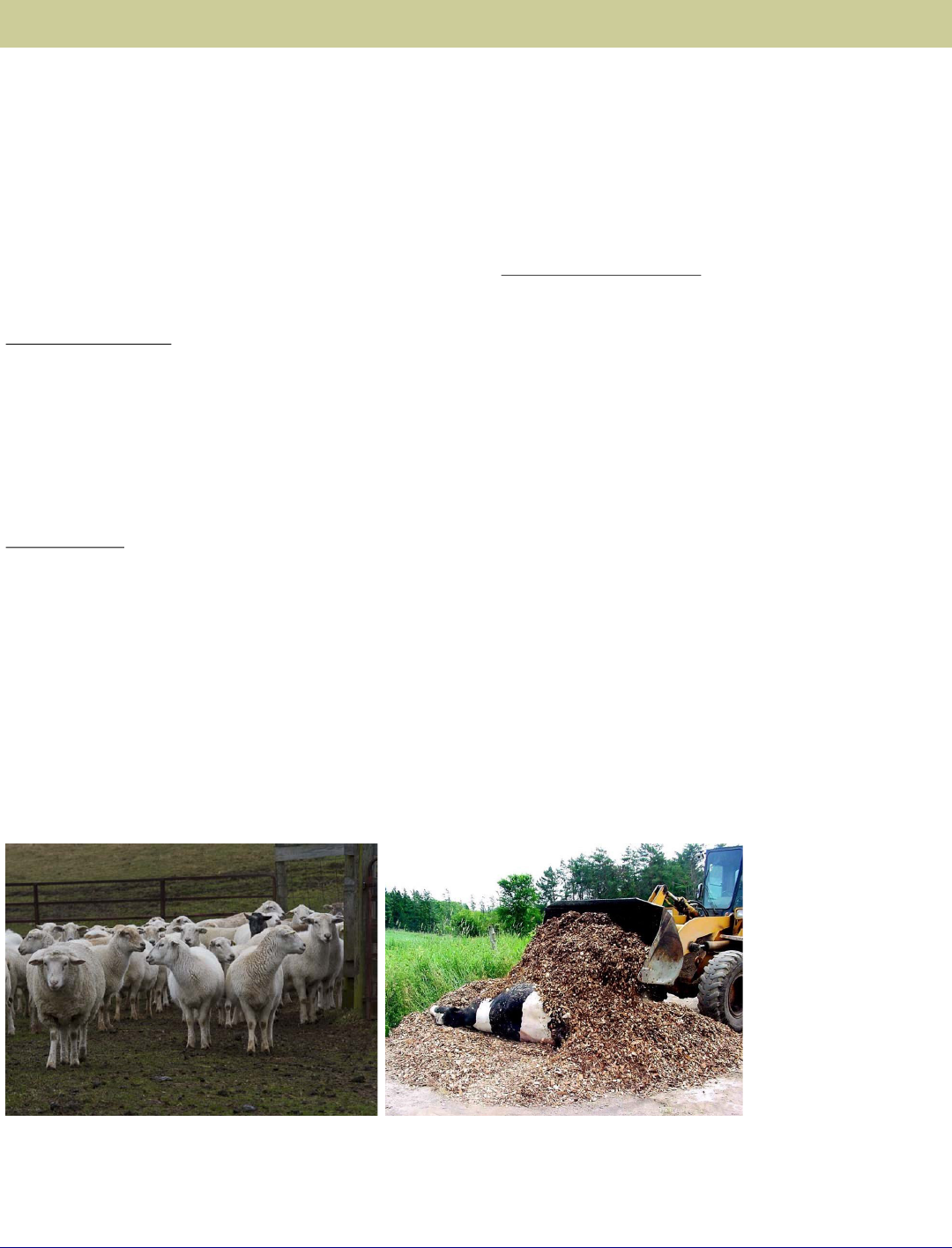
Altering animal husbandry to reduce wildlife damage can
be effective but may have limitations. For example,
confinement may not be possible when grazing conditions
require livestock to scatter. Hiring extra people, building
secure holding pens, and adjusting the timing of births is
usually expensive. The expense associated with a change
in husbandry practices may exceed the savings.
Flock and Herd Health
Poultry and livestock breeds with stronger flocking and
herding behaviors may be less vulnerable to coyote
depredation. Coyotes often take advantage of prey with
compromised health conditions. Proper feeding and care of
livestock helps ensure stronger young that are less vulnerable
to coyote depredation.
Record Keeping
Good record keeping and animal identification systems are
invaluable in a livestock operation. Records help producers
identify loss patterns or trends related to coyote depredation,
as well as determine what type and amount of coyote
damage management is feasible. Records also identify
critical problem areas that may require attention. For
example, records may show that losses to coyotes are high in
a particular pasture in early summer, requiring proactive
preventive management. Owners who do not regularly count
their livestock may suffer fairly substantial losses before
realizing a problem exists. Such delays make it difficult to
accurately determine if losses are due to coyotes.
Birthing and Raising Young
Both the season and location of birthing and raising young
livestock can affect the severity of coyote depredation.
Coyote related losses of young livestock are typically the
highest from late spring through September when adult
coyotes are feeding young. A fall birthing program is one
option that avoids large numbers of young animals on the
landscape during periods when coyote depredation is high.
Synchronized or group breeding helps shorten birthing
periods and reduces exposure of small livestock to
depredation. When birthing within a concentrated period,
however, extra labor and facilities may be necessary. Some
producers practice early weaning and do not allow young to
go to large pastures, thus reducing coyote depredation. This
also gives orphaned and weaker animals a greater chance of
survival.
Where practical, sheds, pens, small pastures or paddocks for
birthing or raising young livestock can increase survival.
Increased human presence or activity around livestock also
Page 5 U.S. Department of Agriculture
Figure 3. Good animal husbandry practices, such as penning sheep at night and properly burying or disposing of livestock carcasses
(as shown),
can help prevent coyote depredation.

Page 6
WDM Technical Series─Coyotes
helps to reduce coyote depredation. Confining livestock
entirely to buildings nearly eliminates coyote depredation,
though may be impractical in many situations.
Carcass Removal
The proper removal and disposal of dead livestock is
important since carcasses tend to attract coyotes and other
predators, and may result in habituation to that food source
(Figure 3). Coyotes are attracted to easily accessible carrion
and, as a result, depredation losses to nearby livestock can
be higher.
Pasture Selection
Habitat features often change with seasonal crop growth.
Harvested or cultivated fields are often void of coyotes during
winter but provide cover for them during the spring through
fall growing season. This may lead to a corresponding
increase in depredation on nearby livestock.
Livestock in remote or rugged pastures are usually more
vulnerable to coyote depredation than those in closer, more
open, and smaller pastures. A relatively small, open, tightly-
fenced pasture that can be kept under close surveillance is
generally a good choice for birthing livestock, if lambing sheds
are unavailable. Also consider previous coyote presence in the
area, as well as weather and disease issues.
At times, coyotes kill in one pasture and not in another.
Changing pastures during these times of loss may reduce
depredation. Pasture features, like slope, rough or broken
terrain, brushy cover, and lack of human activity, provide ideal
conditions for coyotes. Pastures adjacent to streams, creeks,
or rivers may be more prone to coyote activity since water
courses serve as coyote hunting and travel corridors.
Herders/Shepherds
Using herders or shepherds to watch over livestock in large
pastures can help reduce coyote depredation. If herders are
not used, daily or periodic checks on the livestock is a good
animal husbandry practice.
Denning
Coyote depredation can be reduced by locating coyote dens
(Figure 4) and lethally removing the adults and young of the
year (known as denning). Denning is prohibited in some
areas. Check local and state regulations and restrictions.
Denning may be warranted as a preventive control strategy if
coyote depredation historically or consistently occurs in a
particular area. Although denning requires special skills,
training, and considerable time, the advantages can be
significant.
Mated coyote pairs are extremely protective of their territory
when raising young and will vigorously defend it from other
coyotes. Coyotes often den year after year in the same
general location. If a particular denning pair of coyotes has a
history of existing with and not preying on livestock, it may be
advantageous to leave them alone. Their removal will open
up a territory that may become occupied with coyotes that
could prey on livestock.
Tracking a coyote from a kill site back to its den is one
method for locating a den site. This can be done by patiently
observing from a distant vantage point. A trained trailing
hound also may be useful for this task. If the general area of
the den is known, use a predator call to imitate a coyote howl.
This usually solicits a response from any nearby coyote and
helps determine the den’s location.
Figure 4. Coyote den.

Aircraft can be used to locate coyote dens when
depredations occur in spring or early summer. Dens are
most easily located after young of the year begin venturing
outside the burrows. Flattened vegetation around the den
site can make it more visible from the air. If legal at the
location, the coyotes can be lethally removed through
aerial operations; otherwise, note the location and return
on foot or by vehicle.
Once the den is located, approach the den unseen and
downwind to within calling distance. A call that imitates the
distress whine of a young coyote can draw out the adults,
especially when used in conjunction with a specially-
trained dog to act as a lure/decoy. The sound of a young
coyote in distress, along with the sight of a dog near the
den causes most coyotes to display highly aggressive
behavior, frequently chasing the dog and coming out into
the open where they can be lethally removed with a
firearm. After the adults are removed, a trained applicator
can fumigate the den with a large gas cartridge registered
for this purpose (see Fumigants).
Exclusion
New materials and designs have made fences an effective
and economically practical method for preventing coyote
access to pastures, airport environments, backyards, and
other areas. However, many factors, including the density,
behavior and motivation of coyotes, terrain and vegetative
conditions, availability of other prey, size of pastures, and
time of year, as well as the fence design, construction, and
maintenance, will impact the overall effectiveness of a
fence.
It is unlikely that fences will totally exclude all coyotes from
an area, especially large areas or ranges; however, fences
can increase the effectiveness of other damage
management methods, such as penning livestock, using
guard animals, and trapping. For example, the combined
use of livestock protection dogs (LPD) and fencing
sometimes achieves a greater degree of success than
either method alone. An electric fence may help keep an
LPD in and coyotes out of a pasture. If an occasional
coyote passes through the fence, the LPD can keep it away
from the livestock and alert the producer by barking.
Fencing can concentrate coyote activity at specific locations,
such as gateways or ravines, that coyotes use to easily gain
access to livestock. Set foothold traps and cable devices at
strategic locations along a fence to effectively capture
coyotes.
While beneficial for livestock, fences can pose problems for
wildlife. In particular, barrier fences may exclude not only
coyotes, but also many other wildlife. Special attention
should be made where fencing intersects wildlife travel or
migration corridors.
Net-Wire Fencing
Well maintained net-wire or barrier fences deter many
coyotes from entering a pasture. Horizontal spacing of the
mesh wire should be less than 6 inches (15 cm), and vertical
spacing less than 4 inches (10 cm). Digging under a fence
can be discouraged by placing barbed wire at ground level or
using a buried wire apron. A fence at least 5.5 feet (ft) (1.6
meters (m)) high will keep coyotes from jumping over it.
Climbing can usually be prevented by adding an electrified
wire at the top of the fence or installing a barbed wire
overhang (Figure 5).
The construction and materials for such fencing can be
expensive. Therefore, fences of this type are rarely used
except around small pastures, corrals, feedlots, or areas used
for temporary confinement.
Page 7 U.S. Department of Agriculture
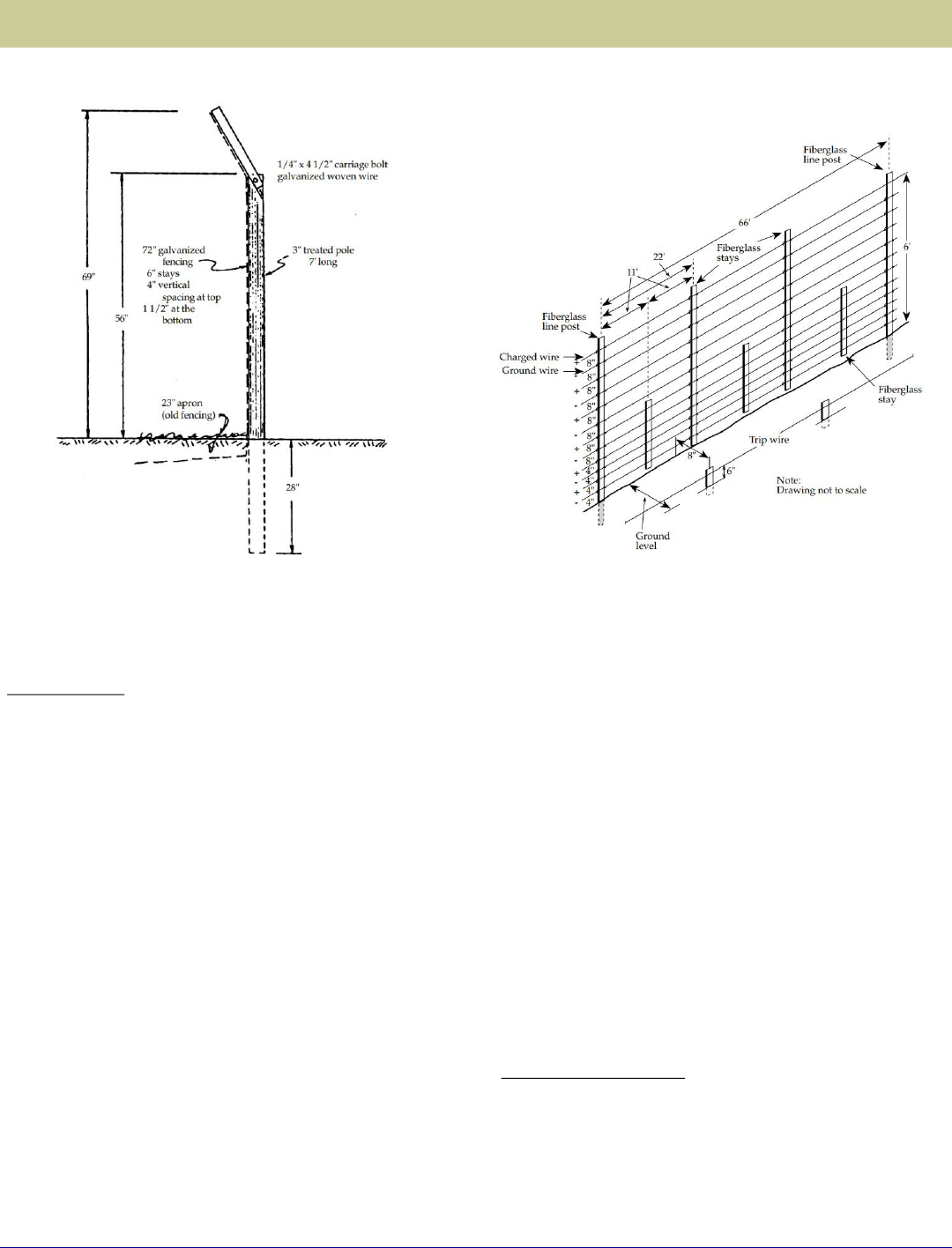
Page 8
WDM Technical Series─Coyotes
Electric Fencing
Modern electric fencing for livestock containment and
exclusion often is constructed of stretched, smooth, high-
tensile steel wire and has chargers that maintain high
output with low impedance which resists grounding and
minimizes fire hazards.
Many electric fence designs charge every wire. A charged
tripwire can also be installed just above the ground about 8
inches (20 cm) outside the main fence to discourage digging
by animals (Figure 6).
Electric fencing is easiest to install on flat or even terrain.
Labor to keep electric fencing functional can be significant
and includes:
• Maintaining wire tension;
• Removing excessive vegetation under the fence to
prevent grounding;
• Repairing damage from livestock or wildlife;
• Regularly checking the charger to ensure it is operational;
and
• Checking for trapped animals inside the fence. These
animals receive a shock as they enter the pasture and
may subsequently avoid approaching the fence to
escape.
In situations where conventional fencing is in good condition,
adding 1 or 2 charged wires can significantly enhance
predator deterrence. A charged wire placed 6 to 8 inches (15
to 23 cm) above the ground at 8 to 10 inches (20 to 25 cm)
outside of the fence can help to prevent digging by animals. If
coyotes are climbing or jumping a fence, add charged wires
to the top or at horizontal levels above the ground. Wires
should be offset and outside of the fence.
Portable Electric Fencing
The advent of safe, high-energy chargers (battery or solar-
powered) has led to the development of portable electric
fences. Electric fencing is created with thin strands of wire
Figure 6. High-tensile electric fence.
Figure 5. Barrier fence with wire overhang and buried apron.
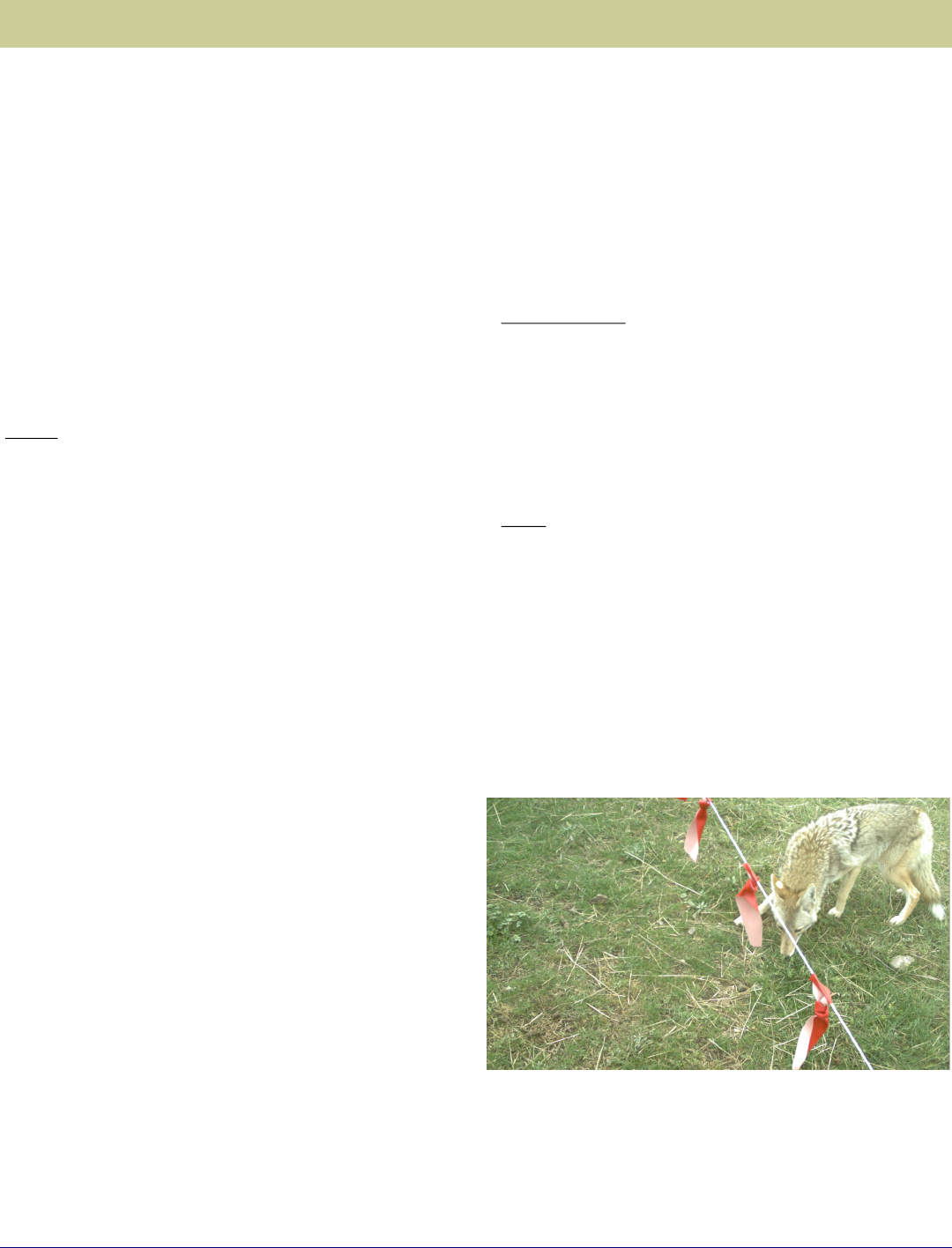
running through polyethylene twine or ribbon, called poly-wire
or poly-tape. The poly-material is available in single and
multiple wire rolls or as a mesh fence of various heights. It
can be quickly and easily installed to serve as a temporary
corral to avoid depredation at places or periods of high risk
(i.e., at night), to partition off pastures for controlled
grazing, or to protect threatened or endangered species
nesting sites (e.g., sea turtles, piping plovers) from
depredation. Note that range livestock that are not
accustomed to being fenced may be difficult to contain in a
portable fence.
Corrals
Confining livestock in a corral at night helps to reduce
depredation. Adding light, noise, and using an enclosure with
good structural integrity also increases the effectiveness of
corrals. Keeping livestock penned on foggy or cloudy days
may be helpful, as coyotes seem to be more active under
those conditions.
The potential downsides of using corrals include building
costs and labor, herding, and feeding livestock. Additionally,
confined livestock may increase parasite and disease
problems within the flock or herd.
Fertility Control
No fertility control agent is currently available for use with
coyotes. Past research on fertility control (e.g., sterilization,
reproductive inhibitors, and chemical treatments) reveals
some success in reducing coyote depredation, as treated
territorial pairs no longer need to provide for young of the
year. However, the costs may be limiting, and in some
cases, annual treatment is required. These methods
remain an area of research, but may not be practical nor
effective on coyote populations.
Frightening Devices
Coyotes are often suspicious of novel stimuli and frightening
devices are most useful for reducing coyote damage during
short periods of time. Avoid acclimation by varying the
position, appearance, duration, or frequency of the
frightening stimuli, or using them in various combinations.
A variety of frightening devices and equipment exists,
including animated scarecrows, fladry, lights and alarms,
and propane cannons. Many are battery powered, motion-
activated or programmable, and provide a variety of
sounds or lights to frighten coyotes from the protected
area.
Bells and Radios
Some livestock producers place bells on some or all of
their livestock to discourage predators. Livestock are easily
located, and the unnatural or unfamiliar sounds associated
with them may discourage predators. A radio tuned and
playing a 24-hour station may be a temporary deterrent in
smaller penned areas or enclosures.
Fladry
Fladry consists of a line of brightly colored flags hung at
regular intervals along the perimeter of a pasture. For extra
protection, the line carrying the flags can be electrified,
which is known as “turbofladry.”
Because carnivores are often wary of new items in their
environment, like fluttering flags, they are cautious about
crossing the fladry barrier—at least for 3 to 4 months. That
Page 9 U.S. Department of Agriculture
Figure 7. A 2019 USDA study showed fladry made with the top-knot design
(shown)
and
with flags spaced 11 inches (27.9 cm) apart was the most effective at preventing
coyotes from crossing a fladry barrier.

Page 10
WDM Technical Series─Coyotes
added time of protection may be enough to protect calves
and lambs during critical periods. The effectiveness may
be short-lived for coyotes as they are quite adaptable to
this type of novel stimuli. A 2019 USDA Wildlife Services
study showed fladry made with a top-knot design and with
flags spaced 11 inches (27.9 cm) apart was the most
effective at preventing coyotes from crossing a fladry
barrier (Figure 7).
Lights
Lighting can act as a deterrent to coyotes, particularly in
confined areas, such as corrals. Use daylight sensors or
timers to activate the lights and reduce electricity costs.
Revolving, flashing, or strobe lights with motion detectors may
enhance their effectiveness.
Propane Cannons
Propane cannons produce loud discharges at timed intervals
when a spark ignites a measured amount of propane gas. On
most models, the time between discharges can vary from 1
to 55 minutes. Their effectiveness at frightening coyotes is
usually temporary, but it can be increased by moving
cannons to different locations every 3 to 4 days, varying the
intervals between discharges, and using them in conjunction
with other frightening devices. In pastures, propane cannons
should be placed on rigid stands or T-posts. Elevated propane
cannons reduce the potential for rodent infestations in the
equipment that could cause malfunctions. Cannons can be
fitted with timers to allow them to come on at predetermined
times (e.g., before dark and at daybreak). Depending on
location especially in relation to neighbors, noise may be a
consideration.
Scarecrows
Scarecrows, air dancers or similar erect figurines may be
effective predator frightening devices for short periods of
time. Adding movement to the figurine increases its
effectiveness. Air dancers with supplemental lighting may
be useful as nocturnal frightening devices.
Strobe Lights and Sirens
The USDA Wildlife Services program developed a frightening
device called the Electronic Guard (EG) (Figure 8). The EG
consists of a strobe light and siren controlled by a variable
interval timer that is activated at night with a photoelectric
cell. In tests conducted in fenced pastures, EGs reduced
depredation by approximately 89 percent. Most research on
the effectiveness of EGs has been done with sheep
operations. EG use differs for pastured versus ranged sheep
operations. Although EGs are no longer manufactured by
USDA Wildlife Services, similar devices are sold by private
companies. Tips for using the EG and similar devices with
fenced and pastured sheep include:
• Placing devices above the ground on fence posts, trees,
or T-posts so they can be heard and seen at greater
distances and to prevent livestock from damaging them;
• Positioning devices so that rainwater cannot enter the
device and cause a malfunction;
Figure 8. Strobe lights and sirens, such as those used in an Electronic
Guard
(shown)
and similar devices, reduce livestock depredation
during short periods of time and have little to no negative impacts on
livestock behavior.
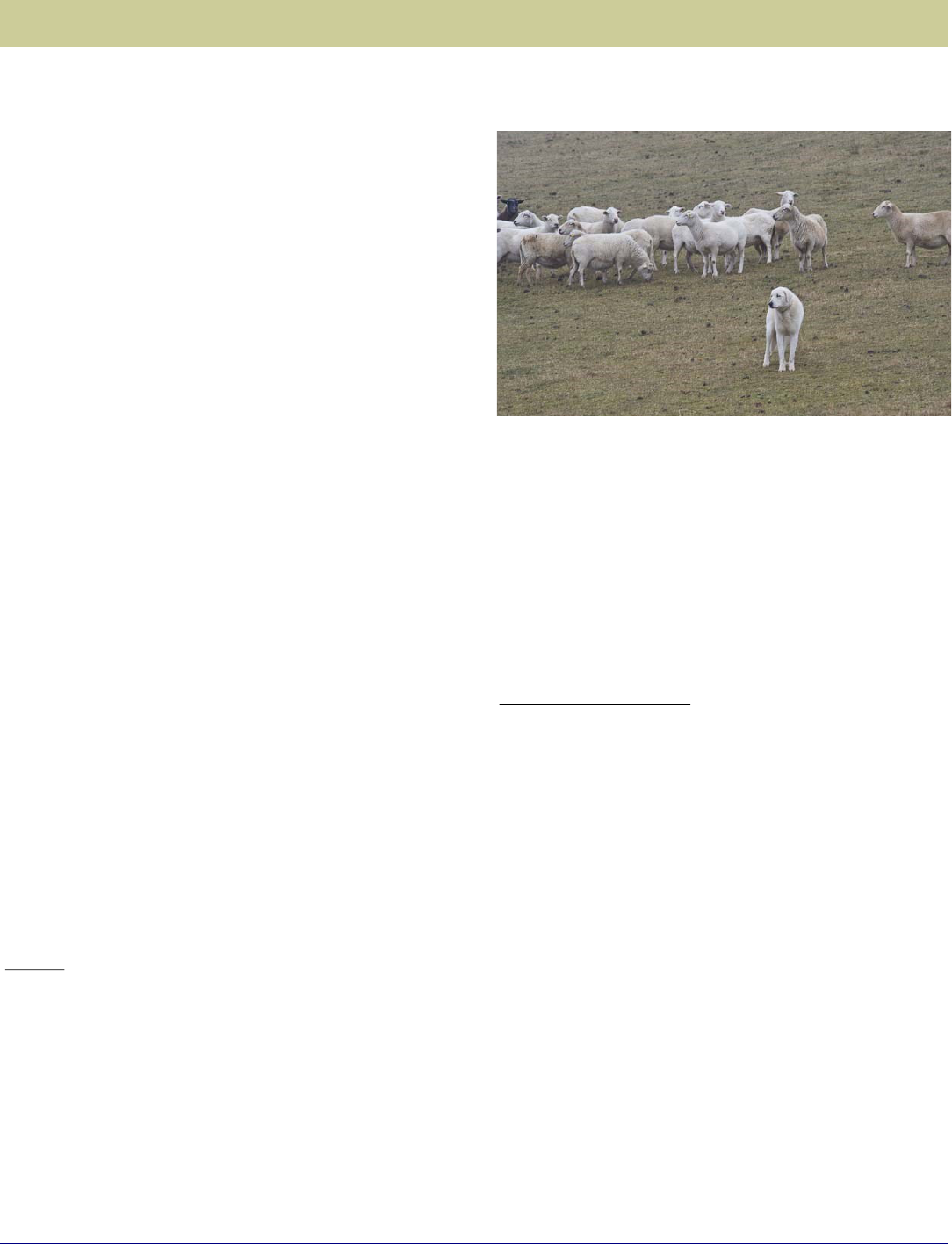
• Positioning devices so that light can enter the photocell
port or window. If positioned in deep shade, the device
may not turn on or off at the desired times;
• Using at least 2 units in small (<30 acres/12 ha), level,
short-grass pastures; 3 to 4 units in medium (<100
acres/40 ha), hilly, tall grass, or wooded pastures; and
4 to 8 units in larger pastures (>100 acres/40 ha) where
livestock congregate or bed; and
• Placing devices on high spots, where depredation has
occurred, at the edge of wooded areas, near or on
bedding grounds, or near suspected coyote travel
corridors. The devices should be moved to different
locations every 10 to 14 days to reduce acclimation.
The number of devices used in open range situations
depends on the number of livestock and size of their bedding
grounds. Herders who bed their livestock tightly have better
results than those who allow bedding over large areas. Tips
for using the devices with open range or herded livestock
include:
• Using 4 EGs in bedding areas to protect herds of 1,000
head and their young;
• When possible, placing an EG in the center of the
bedding ground and others around the edge. Try to place
the units in suspected coyote travel corridors; and
• Placing EGs on high points, ridge tops, edges of
clearings, or on high rocks or outcroppings. Hang the
devices on tree limbs 5 to 7 ft (1.5 to 2.1 m) above
ground level. If used above timberline or in treeless
areas, hang them from a tripod of poles.
Vehicles
Coyotes associate vehicles with human activity. Parking cars
or pickups in areas where losses are occurring may
temporarily reduce depredation. Effectiveness can be
improved or extended by frequently moving the vehicles to
new locations.
Guarding Animals
The use of guarding animals, such as dogs and donkeys, to
protect flocks and herds from predators is a common
nonlethal predation damage management tool.
Livestock Protection Dogs
Livestock protection dogs (LPDs) have been used for
centuries to protect livestock, primarily domestic sheep,
from large carnivores (Figure 9). LPDs are raised and
trained to stay with livestock without harming them. Their
protective behaviors are largely instinctive, but proper rearing
plays a part. LPDs should be acquired from a trained,
reliable, and professional breeder.
Breeds commonly used as LPDs include the Great Pyrenees,
Komondor, Anatolian Shepherd, and Akbash. Other Old-World
breeds include Maremma, Sharplaninetz, and Kuvasz. LPDs
typically live for about 10 years. Mixed breeds may be
developed to provide for certain traits or needs.
USDA Wildlife Services research on the use of three larger
European LPD breeds (Portuguese Transmontanos, Bulgarian
Karackachans, and Turkish Kangals) to prevent depredation
by predators larger than a coyote, such as grizzly bears and
Page 11 U.S. Department of Agriculture
Figure 9. Livestock protection dogs (LPDs) have been used for centuries to protect
livestock from predators.

Page 12
WDM Technical Series─Coyotes
wolves, determined that all the breeds successfully,
protected sheep, but showed different guarding traits
and behaviors. Producers may want to balance the traits of
multiple dog breeds by having some that prefer to stand
guard with the flock and some that seek out and
investigate potential threats.
The characteristics of each livestock operation dictates the
number of dogs required for effective guarding. If coyotes are
scarce, one dog is sufficient for most fenced pasture
operations. Range operations often use two dogs per herd of
livestock. The performance of individual dogs differs based
on age and experience.
Coyote density, as well as the size, topography, and habitat of
the pasture or range must also be considered. Relatively flat,
open areas can be adequately covered by one dog. When
brush, timber, ravines and hills are in the pasture, several
dogs may be needed, particularly if the livestock are
scattered. Livestock that flock and form a cohesive unit,
especially at night, can be protected by one dog more
effectively than livestock that are scattered and bedded in a
number of locations.
Donkeys
Donkeys or burros are generally docile to people but seem to
have an inherent dislike for dogs and other canids. The
typical response of a donkey to an intruding canid may
include braying, bared teeth, a running attack, kicking, and
biting. Pasturing a donkey with sheep, goats or other
compatible livestock can help reduce coyote depredation.
Donkeys are less expensive to obtain and care for than
LPDs, and may be less prone to accidental death and
premature mortality. An average lifespan for a donkey is 33
years. Donkeys can be used with relative safety in
conjunction with other damage management tools, such as
cable devices, foothold traps, and toxicants.
For more information about donkeys, see Appendix II.
Llamas
Like donkeys, llamas have an inherent dislike of canids, and
a growing number of producers are using llamas to protect
their livestock. Llamas bond with sheep or goats within hours
and offer advantages over guarding dogs similar to those
described for donkeys. The average lifespan for a llama is 20
years.
Other Animals
Any animal that displays aggressive behavior toward intruding
coyotes may offer some benefit in deterring depredation.
Other animals reportedly used for reducing depredation
include mules, ostriches, and larger breeds of goats.
The USDA Wildlife Services program tested whether the
bonding and pasturing of sheep and goats with cattle helped
to protect them from coyote depredation. Results showed the
sheep and goats that remained near cattle did receive some
protection. Whether this protection was the result of direct
actions by the cattle or by the coyotes’ response to the cattle
is uncertain. Multi-species grazing allows for optimal foraging
practices and may also help reduce coyote depredation.
Habitat Modification
Modify habitats to eliminate or reduce areas that provide
cover, resting habitat, or travel corridors for predators.
Prevent prey species, such as deer, pheasants, rabbits, or
turkeys from gathering too close to human habitation or
with livestock. Completely remove dead animal carcasses
from pastures or bury them deep in place.
Hazing
Hazing (i.e., scaring) coyotes involves people yelling,
throwing objects or aggressively approaching individual
coyotes more frequently so that coyotes retain or gain
more fear of people. It is commonly promoted as a
nonlethal method to reduce urban coyote conflicts. USDA
Wildlife Services’ studies with captive coyotes suggest that
hazed coyotes learn to avoid behaviors, such as getting too
close to people, that might result in more hazing.
Additionally, coyotes that were fed or followed by a dog
were more likely to approach a person even if it resulted in
hazing. Coyote hazing can work in certain situations, but
researchers note a coyote’s past experiences with people
influences the technique’s effectiveness.

Coyotes can be called at any time of the day, although shortly
after dawn and just before dusk are usually best anywhere
they are present. Night and thermal vision optics may extend
predator calling opportunities after dark. Some coyotes come
to a howl without howling back.
Night Operations
Shooting coyotes at night using thermal vision, night vision,
or artificial light may be effective. This technology may also be
useful for observing coyote behavior at night.
Review all local restrictions or regulations concerning
discharging a firearm during hours of darkness and the use of
thermal or night vision equipment. Seasonal restrictions or
requirements may also exist if night operations are conducted
during regulated harvest seasons.
For safety reasons, areas targeted for night operations should
be scouted in advance during daylight. Create range maps
with determined distances, locations of occupied or
unoccupied structures, or terrain features that may hide an
advancing coyote. Take special note of penned or pastured
livestock, or the presence of domestic canines. Be familiar
with the equipment and able to accurately identify coyotes
during hours of darkness.
Aerial Operations
The use of aircraft for shooting coyotes is regulated by the
Airborne Hunting Act and is allowed under special permit in
states where legal. Aerial operations are very selective,
allowing for the removal of targeted species. It is an effective
alternative for removing coyotes that have evaded other
methods, such as trapping.
Fixed-wing aerial operations is limited primarily to open areas
with little vegetative cover. Due to their maneuverability,
helicopters are more effective for shooting in areas of brush,
scattered timber, and rugged terrain.
Although aerial operations can be conducted over bare
ground, it is most effective with snow cover. Coyotes are
more visible against a background of snow than green or
brown vegetation. Their tracks are also more visible in the
snow. Flying a grid pattern ensures areas are not missed.
Page 13 U.S. Department of Agriculture
Repellents
No effective chemical repellents are available to repel
coyotes.
Relocation
Capturing and moving animals (also known as relocation)
is rarely legal nor is it considered a viable solution by
wildlife professionals for resolving certain wildlife damage
problems. Reasons to avoid relocating wildlife include legal
restrictions, disease concerns, liability issues associated
with injuries or damages caused by a relocated animal,
stress to the animal, homing behavior, and risk of death to
the animal. Check state and local regulations before
considering relocation.
Shooting
Shooting is a common method for lethally removing coyotes.
Safety is a critical factor and may preclude the use of
firearms due to local laws or human habitation. Consider all
available management options and proceed accordingly.
The choice of firearm, caliber, and bullet will vary based on
circumstances in the field. For instance, distance to target is
important in the selection of the appropriate firearm
(shotgun or rifle). The accuracy of firearms may be enhanced
with accessories, such as night vision, illuminated or fiber
optic sights, adjustable trigger assemblies and stocks, and
tripods or shooting stands.
Predator Calling
Predator calling is used to locate coyotes or draw them close
for shooting purposes. Common sounds used in predator
calling replicate coyote howling, young coyote whining or
distress sounds, and prey animal (cottontail, jackrabbit, bird,
or young ungulates) distress sounds.
Predator calls can be hand-held and mouth-blown reed calls,
or recorded sounds amplified through a battery-operated
player and speaker. Advances in recording and player
technology have allowed for remote use, and the opportunity
to select from a variety of stored recordings that create
realistic sounds.

Page 14
WDM Technical Series─Coyotes
Aerial crews generally fly the grid with the sun at their
backs, allowing the sunlight to highlight coyotes and other
ground features.
A ground crew assists with aerial operations. Before the
aircraft arrives, the ground crew often works to locate coyotes
in the area by eliciting howls. Two-way radio communication
allows the ground crew to direct the aircraft toward the sound
of the coyotes, thus reducing search times.
Aerial operations require special skills and training for both
the pilot and gunner. Weather, terrain, and state or local laws
limit the application of this method.
Toxicants
Pesticides are an important component in integrated wildlife
damage management and their use is regulated by federal
and state laws. All pesticides used in the United States must
be registered by the U.S. Environmental Protection Agency
(EPA) under the provisions of the Federal Insecticide,
Fungicide, and Rodenticide Act, as well as the appropriate
state agency. Registered pesticides must be used in
accordance with label directions. Some pesticides can only be
applied by persons who have been specially trained and
certified for their use. Each of the chemical methods listed
below have specific requirements for their handling, transport,
storage, application, and disposal.
Three toxicant active ingredients and eleven end-use products
are registered with the EPA for use with coyotes to reduce
predation.
Sodium Cyanide and the M-44
Sodium cyanide is used in the M-44 ejector device (EPA Reg.
Nos. 56228-15, 35978-1, 35975-2, 39508-1, 33858-2, and
13808-8; products are all named M-44 Cyanide Capsules).
EPA Reg. No. 56228-15 can only be used under the
supervision of the USDA Animal and Plant Health Inspection
Service (APHIS), and EPA Reg. Nos. 35978-1, 35975-2,
39508-1, 33858-2, 13808-8 can only be used under the
supervision of the state’s department of agriculture.
The M-44 is a spring-activated device that delivers a dose
of sodium cyanide powder from the cyanide capsules to a
coyote. All six M-44 cyanide capsule products are
registered as Restricted Use Pesticides (RUP) by the EPA
and can be used only by specially trained certified
pesticide applicators who must comply with a number of
product-specific use restrictions designed to protect
people, domestic animals, and non-target wildlife.
The M-44 ejector device consists of four parts: a capsule
holder wrapped with cloth, wool, or other soft material; a
cyanide capsule (small plastic container holding less than
1 gram of sodium cyanide); a spring-activated ejector; and
a 5- to 7-inch tubular stake. In the field, the stake is
typically inserted with its top near the surface of the
ground (Figure 10). In specialized circumstances, the top
may be lower than the surrounding surface (i.e., the device
is set in a hole or depression) so as not to be stepped
upon, disturbed by large livestock, or seen by nontarget
scavenging birds. The cyanide capsule is inserted into its
holder and screwed onto the ejector. The ejector is placed
into the stake and secured. Specially formulated bait or
other attractant, which elicits a "bite and pull" response by
coyotes, is smeared on the wrapped capsule holder.
The M-44 device is triggered when a coyote bites and pulls
on the baited capsule holder, releasing the plunger and
Figure 10. The M-44 device is staked with its top placed near the surface of the
ground.
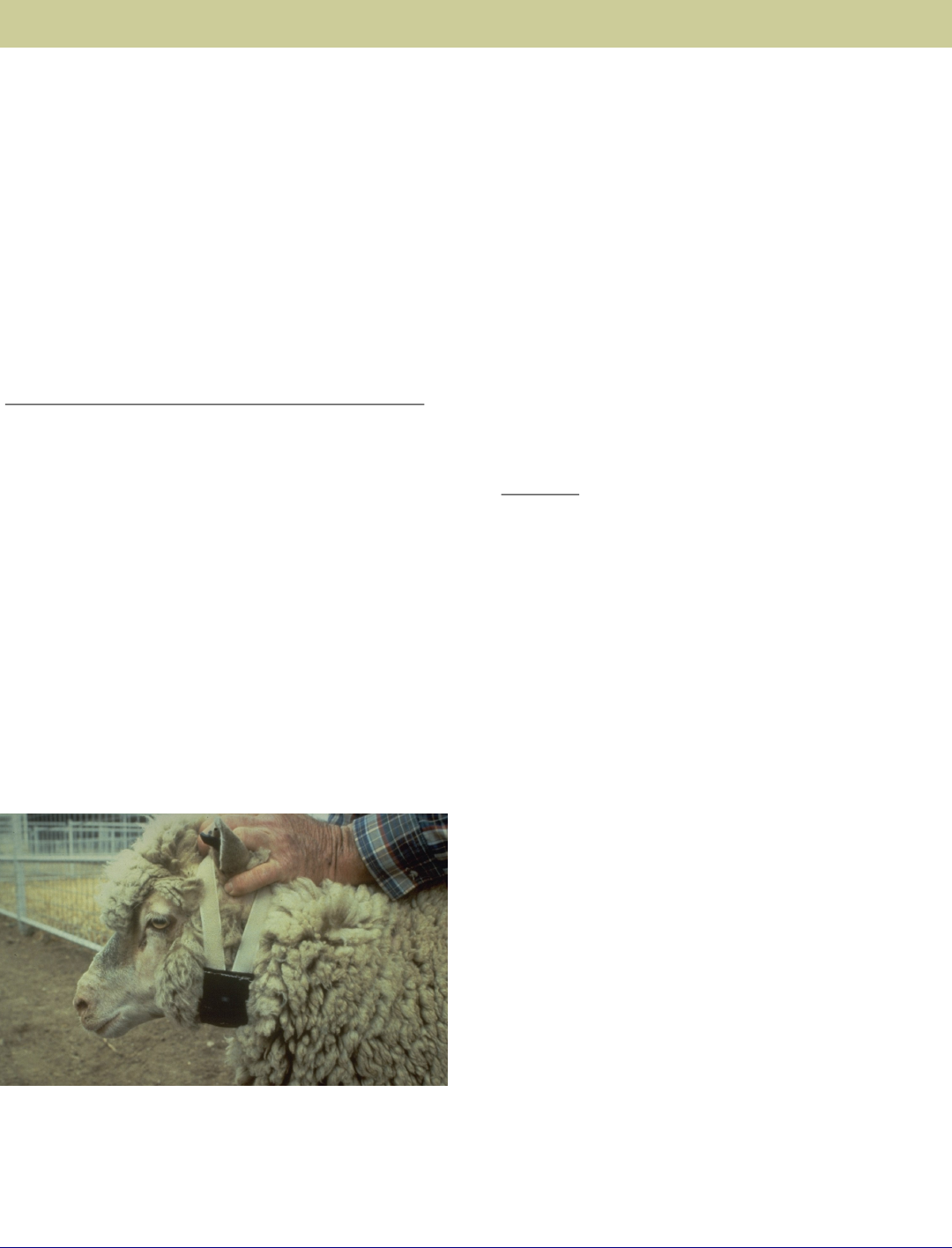
ejecting sodium cyanide powder into the coyote’s mouth.
The sodium cyanide quickly reacts with moisture in the
mouth, releasing hydrogen cyanide gas. Death is quick,
normally within 1 to 5 minutes after the device is triggered.
While the use of traps or cable devices may present a hazard
to livestock, M-44s can be used with relative safety in
pastures where livestock are present. M-44s remain
operational in adverse weather conditions like rain, snow, and
freezing temperatures.
Sodium Fluoroacetate and the Livestock Protection Collar
Sodium fluoroacetate (also known as Compound 1080) is
used in the Livestock Protection Collar (LPC) (EPA Reg. Nos.
56228-22, 39508-2, and 46779-1; products are all named
Sodium Fluoroacetate (Compound 1080) Livestock
Protection Collar). In Ohio, EPA Reg. No. 56228-22 can be
used only by USDA Wildlife Services applicators. EPA Reg. No.
39508-2 can only be used in New Mexico and EPA Reg. No.
46779-1 can only be used in Texas.
LPCs are worn around the necks of sheep or goats in a
group of animals experiencing predation. LPC products are
one of the most selective methods available to manage
coyote predation as only the coyote that attacks a sheep or
goat fitted with an LPC is killed (Figure 11). A coyote must
bite the prey animal on the neck and puncture one or both
sodium fluoroacetate reservoir bladders attached to the
collar to receive the toxicant. The sodium fluoroacetate is
ingested by the coyote and results in its death.
Typically, only operations with frequent or high depredations
justify the use of LPCs given the cost of the collars, sacrificed
livestock, and complying with use restrictions.
The LPC products are registered by the EPA as a RUP, and
certified applicators must be specially trained in their use.
Applicators must follow all label directions and Use
Restrictions contained in the LPC product’s accompanying
Technical Bulletin.
Fumigants
Large gas cartridges (EPA Reg. Nos. 56228-21 and 56228-
62) are products used for denning coyotes. The Large Gas
Cartridge (EPA Reg. No. 56228-62) can be used by any
person 16 years old or older. The APHIS-Only Large Gas
Cartridge (EPA Reg. No. 56228-21) can only be used by
trained USDA Wildlife Services applicators. Information on
registration status and availability of these products in
individual states may be obtained from the respective state’s
pesticide regulatory agency and from USDA Wildlife Services.
Large gas cartridges are registered, general use fumigant
products which contain 53% sodium nitrate, 28% charcoal,
and 19% inert ingredients to produce primarily carbon
monoxide along with other lethal gases in minor quantities
when ignited. A cartridge is lighted, placed as deep as
possible within the coyote den, and the den opening is sealed.
Death occurs when the lethal gasses are inhaled. Care
should be taken to plug dens with nonflammable material,
typically soil or rocks, to minimize the chance of nearby
grasses and leaf litter from catching fire. Gas cartridges
also may be used to euthanize coyotes that flee down a
hole during aerial operations.
Page 15 U.S. Department of Agriculture
Figure 11. The Livestock Protection Collar (LPC) is one of the most selective
methods available to manage coyote predation on sheep and goats—only the
coyote that attacks a sheep or goat fitted with an LPC is killed.
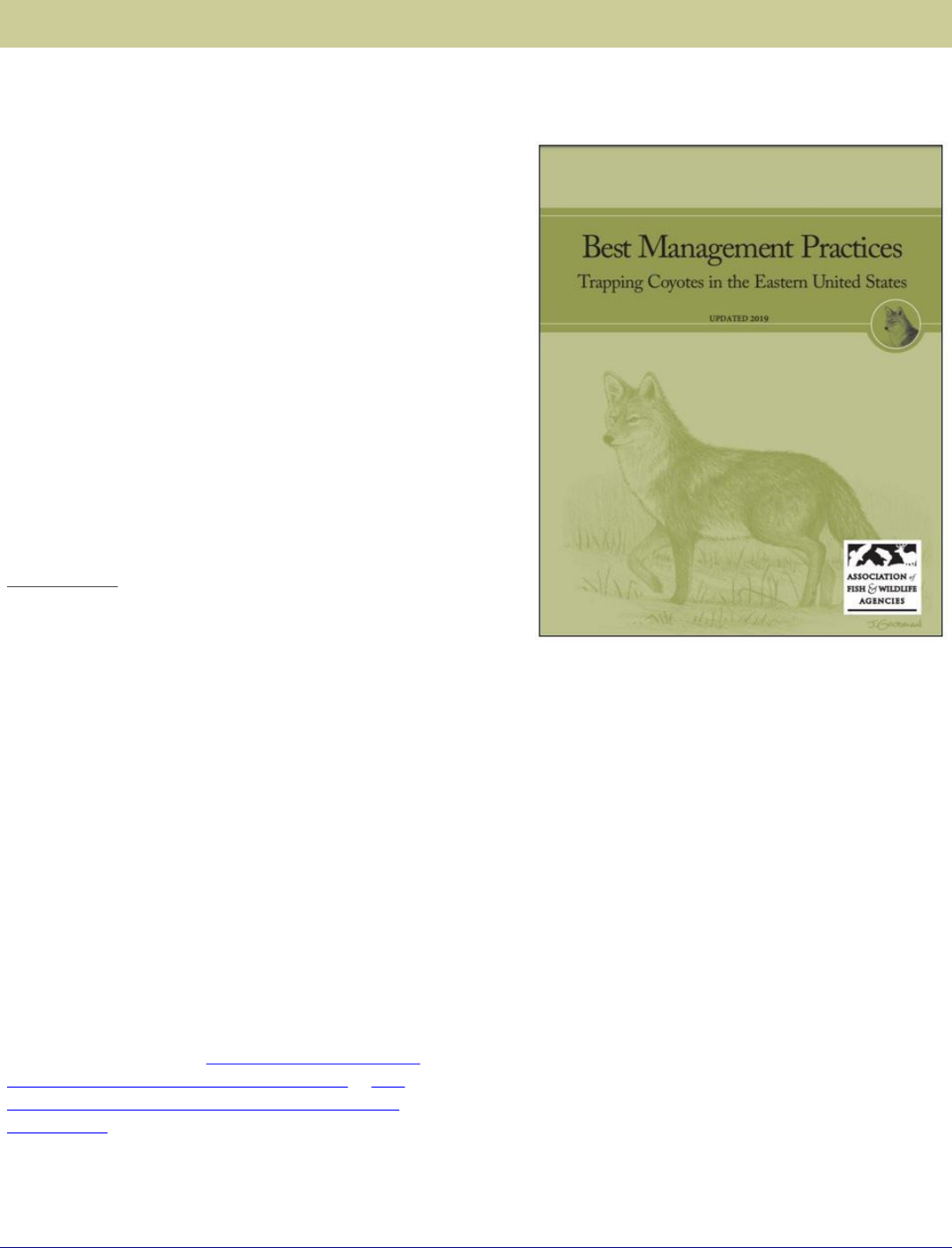
Page 16
WDM Technical Series─Coyotes
Trapping
Trapping describes foothold traps, cage traps, and cable
devices commonly used to capture coyotes. Foothold and
cage traps are designed to live-capture coyotes. Cable
devices are designed to either live-capture or lethally
remove coyotes.
Trapping rules and regulations vary by state. Consult local
laws and regulations prior to using any traps or cable
devices.
Trapper education programs exist in many states. This
training may be required prior to receiving a trapper’s
license and actively trapping. Check with the local state
agency for requirements and training opportunities. If none
exist, the Association of Fish and Wildlife Agencies (AFWA)
and some states offer online training.
Foothold Traps
For more information on the use of foothold traps, please
see Appendix III.
Foothold traps should be purchased from reliable trap
manufacturers or supply outlets. Foothold traps for coyotes
vary in size and strength, allowing for use with different
sized animals (e.g., eastern coyotes [larger] versus western
coyotes) and environmental conditions (e.g., soil, moisture,
and temperature).
Common foothold trap sizes for coyotes range from #1½
(small) to #4 (large) and use either coiled springs or double
long springs. There are no manufacturing standards for
correlating these numbered foothold traps with their
dimensional measurements. Attributes like jaw spread,
spring strength, and stock nomenclature vary between
manufacturers. AFWA continues extensive research with
foothold traps, using criteria to measure the effects on
animal welfare, selectivity, efficiency, practicality, and
safety. Refer to the guides Best Management Practices:
Trapping Coyotes in the Eastern United States or Best
Management Practices: Trapping Coyotes in Western
United States for recommended sizes and measurements
(Figure 12).
Coyotes are very strong, long legged, and often lunge while
restrained. Proper foothold traps for restraining coyotes
include the following characteristics:
• Offset, laminated, or padded jaws (Figure 13): Offset
jaws provide a space that allows for the mass of the
coyote’s foot. Offset and laminated jaws provide a
wider contact surface, which displaces the closing
pressure over a larger area. Padded jaws have a
replaceable rubber surface;
• 4 lbs (1.8 kg) of pan tension: Pan tension is measured
by applying a known weight to the trap pan to allow the
trap jaws to close. Using 4 lbs of pan tension allows
the foothold trap to be more selective for coyotes and
prevents smaller animals from being captured. It
increases the opportunity for a good foot pad catch
and reduces the potential for injuries and accidental
releases. Testing devices are commercially available
Figure 12. The Association of Fish and Wildlife Agencies provides online
guides to best management practices for trapping.
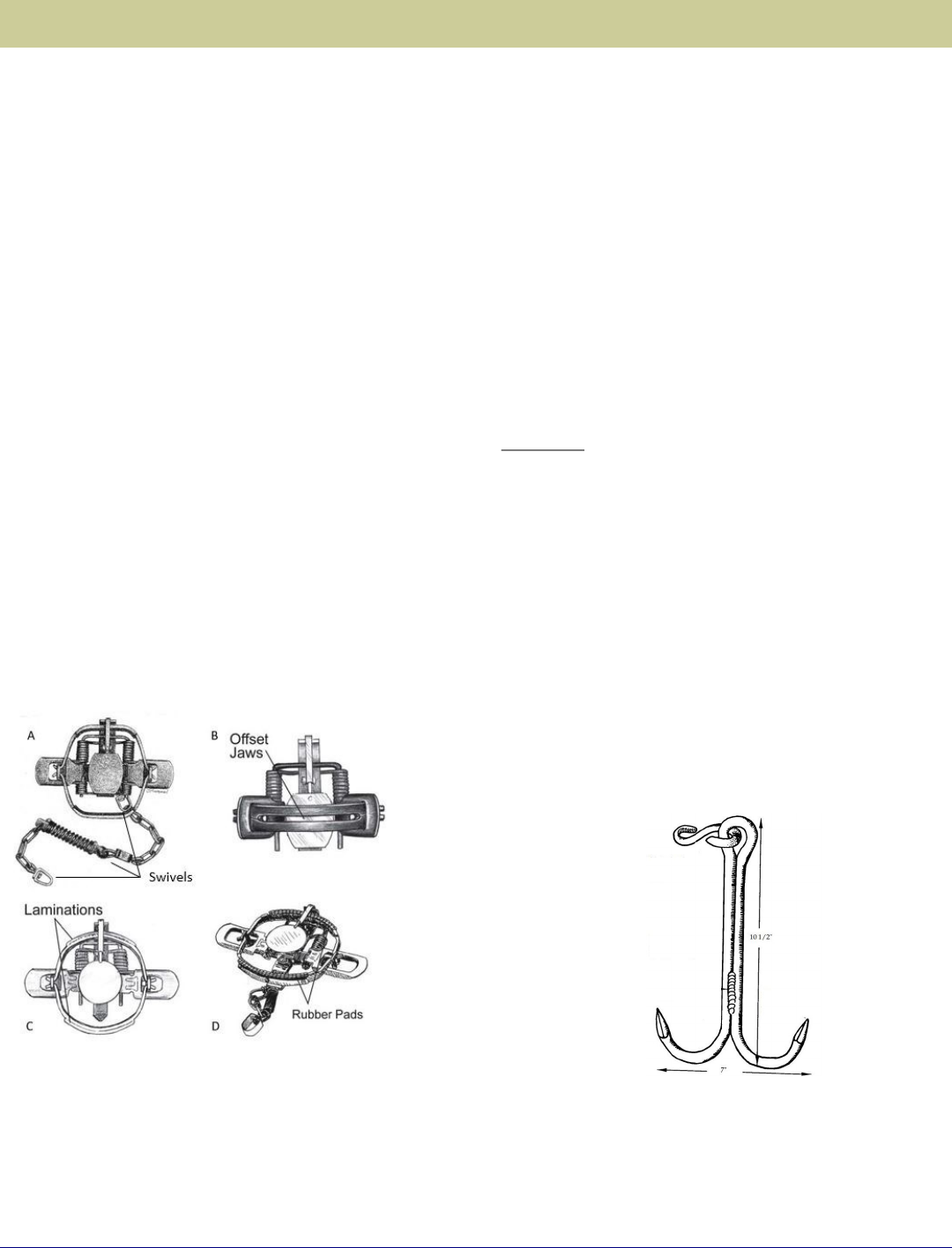
from reliable trapping supply dealers. Pan tension is
typically increased or decreased by adjusting the nut
and bolt that attach the trap pan to the trap base
plate;
• An anchoring chain mounted to the center of the
foothold trap baseplate: Any pulling pressure applied
to the foothold trap is in direct line with the anchor.
This direct line reduces the potential for injury by
preventing the coyote’s restrained foot from sliding
between the foothold trap’s jaws;
• An anchoring chain with multiple in-line swivels:
Swivels allow the foothold trap to turn freely in any
direction and prevents binding which may cause injury
to the restrained foot; and
• An anchoring chain with a shock spring: A shock spring
lessens the impact of a sudden stop if a coyote lunges
while attempting to get free. Shock springs that can
handle 50 to 100 lbs (22 to 45 kg) of pressure are
typically used for coyotes.
Foothold traps set for coyotes are secured with a single
stake or double stake system; earth anchors; or drags
(Figure 14). The soil conditions generally determine what
anchoring system is used. Drags are typically used instead
of in-ground anchors in sandy or loose soils or to allow the
restrained coyote some movement to seek shelter.
Drags commonly use 6 to 10 ft (2 to 3 m) of chain between
the foothold trap and the drag. The drag and chain are
attached to the anchoring chain of the foothold trap. Drags
should be designed to leave marks or a trail so the
restrained coyote can easily be found.
Cage Traps
Cage traps used for coyotes should be at least 48 inches
(1.2 m) long, 16 inches (40 cm) wide, and 23 inches (58
cm) high. Darken the cage trap’s wire with paint or dye, use
vegetation to break up the outline of the trap, and line the
floor of the trap with dirt or vegetation to improve trapping
success. Pre-baiting the cage trap with common food items
which will be used during actual trapping may also help.
Encouraging a coyote into a cage trap is very difficult. Most
coyotes are wary of novel objects. Cage traps may be more
successful in urban or suburban environments where
coyotes are more accustomed to human activity and
human-made objects.
Page 17 U.S. Department of Agriculture
Figure 13. Foothold trap configurations: a) fully modified foothold trap
with center mounted anchoring chain, multiple swivels, and an in-line
shock spring; b) offset jaws; c) laminated jaws; and d) rubber padded
jaws.
Figure 14. A drag is often used when loose soil conditions prevent the use of in-
ground anchors
.
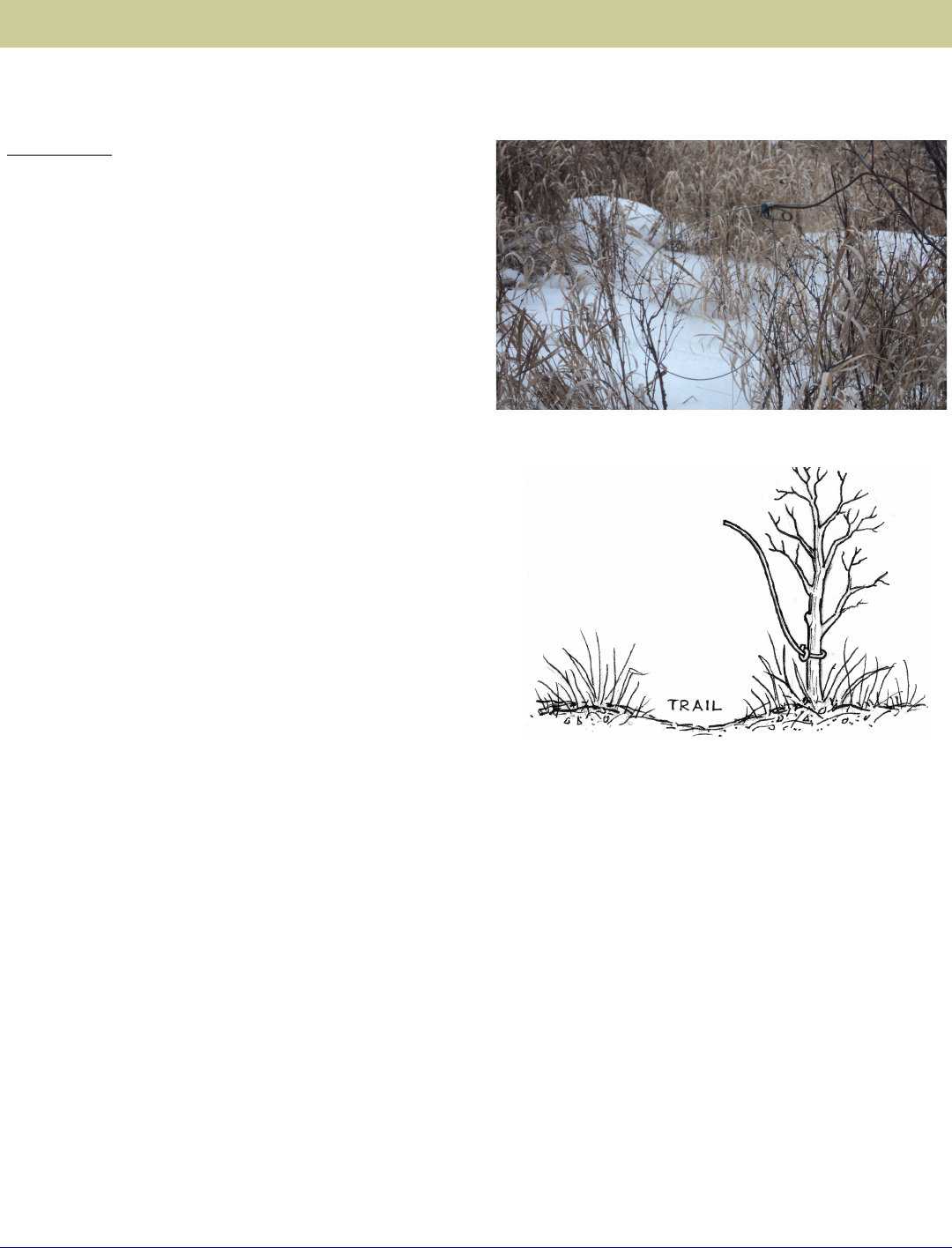
Page 18
WDM Technical Series─Coyotes
Cable Devices
For more information on the use of cable devices, please
see Appendix IV.
Cable devices (or snares) may be designed and set to
either live-capture or lethally remove coyotes.
Cable devices are not legal in all states. Where legal, states
may define the component requirements, measurements,
setting restrictions, and training requirements. Consult local
laws and regulations prior to using cable devices and acquire
legal cable devices from a knowledgeable and reliable
manufacturer. Carefully select sites where snares are set to
avoid capturing nontarget animals, such as dogs.
Unlike other capture tools, cable devices cannot be reused.
Once a capture is made, the stress applied to the cable
makes it unusable. Some cable device components may
be removed and re-used, but the cable itself cannot.
Cable devices are used to capture an unsuspecting coyote
as it is traveling on its commonly used trails (known as
“trailing”). Check the trail for recent tracks. If present,
place the cable device set where the trail narrows.
Approach the location from the side of the trail to prevent
unnecessary disturbance to the site. Position the cable
device’s loop in the center of the trail, so the coyote places
its head through it as it travels along the trail (Figure 15).
The support wire needs to hold the loop tightly and be
sturdy and stiff enough to handle wind and other weather
factors. Nine or 11 gauge wire is commonly used for
support wire (Figure 16). A moving cable device can easily
be detected by an animal or may cause the height and loop
size to change. A cable loop that has fallen may catch a
nontarget animal or may catch a coyote by the foot. Pay
attention to conditions that may change or alter the cable
devices and visit the sets regularly to check them.
Most cable devices are passive capture methods that are
only activated by an animal moving through the loop and
causing it to close. However, some systems are spring-
loaded. When an animal trips the trigger, a compressed
spring propels the cable loop around an animal’s foot or
neck (See Appendix IV). Spring-loaded foot cable devices
are commonly used in lieu of foothold traps in states where
foothold traps have been banned.
Avoid using lure or urine close to a cable device set, with the
exception of foot cable devices. Odors cause a coyote to
investigate, become cautious, or behave differently. The
coyote’s head will not be in line with the body, they may stop
or walk in circles to investigate, and depending on their
status in the area or experiences, they may leave.
Set locations should be on straight runs in the trail, not
curves or changes in direction. Look for a narrowing in the
Figure 15. A properly suspended cable device loop with 9 gauge wire.
Figure 16. A cable device loop support wire made with 9 gauge wire. This set is for a
lethal cable device because of the woody rooted vegetation that provides for
entanglement.

trail. Avoid setting on uphill and downhill parts of a trail—
regardless of which way the coyote is traveling, its head will
not be in a good position to enter the cable device’s loop.
For trails that traverse side hills, anchor the cable device
on the downhill side of the trail. A captured coyote will
naturally work against the anchor downhill and provide
little disturbance to the original set location. This becomes
useful when another set may be needed.
Cable devices must be solidly anchored to an immovable
object. This is imperative for a breakaway component to
function properly, thus allowing the release of large, non-
target animals. A breakaway component is any mechanism
incorporated into a cable device that allows the loop to
disassemble when a specified amount of pressure is
applied. Do not use drags to anchor cable devices as there
is no assurance that the drag will catch on an immovable
object. Fence crossings make excellent set locations for
cable devices, but fencing wire should not be used as an
anchor as it moves when pulled.
Flag or record each set location with colored survey ribbon
as cable devices easily blend in with the natural
surroundings (Figure 17). Wind can move vegetation
around, and snow can change the appearance of the
landscape. If flagging is secured to vegetation, make sure it
is removed when the set is removed. Place flagging adjacent
to the set, not directly above it. In some areas, flagging can
attract people who may disable or take the devices.
Restraining Cable Device: Restraining cable devices are
excellent tools for live-capturing coyotes. This restraint
system is a good choice for use in urban and suburban
environments, or any location where domestic dogs may be
captured. Live restraints have been used effectively for
resolving wildlife conflicts and capturing animals for
research.
Restraining cable devices incorporate a relaxing lock. The
relaxing lock allows the cable’s loop to tighten with tension,
but it does not keep its place on the cable and will move
slightly backward when tension stops. Relaxing locks are
made so that when assembled, the cable passes through
the lock to make the cable loop smaller or larger. The pass-
through holes are slightly larger, allowing the lock to slide
freely on the cable. Even though the lock can move slightly
in either direction on the cable, an animal cannot shed the
loop from its neck.
When setting a restraining cable device, choose set
locations that are free of objects that could cause
entanglement, such as trees, fences, machinery, and any
woody, rooted vegetation larger than ½ inch (1.2 cm) in
diameter.
Page 19 U.S. Department of Agriculture
Figure 17. Colored survey flagging threaded through the center of hinged
clothespins works well for keeping cable devices organized and identifying
set locations. Attach one to each coiled cable device when storing the cable;
remove it and attach it to nearby vegetation or another structure to identify
the set location once the cable device is set; and recover when the cable
device is removed.
Figure 18. An example of a catch circle with a cable device.

traveling coyotes to visit. Some may come to eat, smell
identifiers (like urine or scat) left by other coyotes or leave
scat or urine of their own.
Once coyote sign is found at a draw station, backtrack to
the coyotes’ entrance and exit trails and choose set
locations as far from the draw station as possible (i.e., 100
to 500 yds (91 to 457 m) are recommended). Consider the
following when making a draw station trap set:
• Making sets too close to the draw station may reduce
their effectiveness. The closer a coyote gets to a draw
station, the more alert it becomes. It is their intent not
to surprise or be surprised by another coyote at the
same location. An alert coyote behaves differently than
a trailing coyote and may result in a poor catch or no
catch.
• Setting traps or cable devices too close to a draw
station increases the potential for catching non-target
animals, such as raptors and scavengers that may visit
the site. It is common for birds to land in the open and
walk 10 to 50 yds (9 to 45 m) to reach a draw station.
Using Dogs
Trained dogs often assist in coyote damage management. A
well-trained dog can help locate appropriate places to set
capture devices by alerting their handlers to areas where
target animals have traveled, urinated, or defecated.
Trained dogs can also aid in the application of other
methods by detecting individuals, dens, or attracting coyotes
into shooting range. Properly trained and disciplined dogs
should not make contact with coyotes and have minimal
effect on non-target animals.
Handling and Euthanasia
Wear protective equipment (i.e., gloves, safety glasses)
when handling live or dead coyotes. Avoid contact with
claws, teeth, blood, saliva, urine, or feces.
Coyotes captured in restraining devices may need to be
transported to a different location for euthanasia. A
Page 20
WDM Technical Series─Coyotes
Restraining cable devices are approximately 5 ft (1.5 m) in
length and limit an animal’s free reign when captured. If
this “catch circle” (Figure 18) is not free of objects, an
animal will be able to wrap the cable tight against them
and become entangled. When this occurs, the lock cannot
relax, and the animal will asphyxiate. Restraining cable
devices should be checked daily as they are not designed to
hold live coyotes for long periods of time.
Lethal Cable Device: Lethal cable devices include a non-
relaxing lock. This lock allows the loop of the device to
tighten with tension but prevents it from loosening when the
tension stops.
Many modern cable devices incorporate a small
compression or torsion spring that puts pressure on the
lock to bind it more securely against the cable.
Set lethal cable devices in areas with natural objects that
can cause entanglement and restrict movement, like small
trees or brush, or add an entanglement object. An example
of an entanglement object is a -inch (1.2 cm) diameter
or larger 4 ft (1.2 m) long re-rod stake. These are
commonly called “tangle rods” and are used to support the
cable loop and anchor the device. If a captured coyote is
allowed free reign it may apply great stress to the cable
device, causing a component to fail or providing time for
the coyote to chew through the cable.
Draw Stations
Draw stations are locations that may already exist (e.g.,
carcass disposal sites) or are created by adding lure or bait
to increase coyote interest and activity in an area. A draw
station may be something as simple as lure on a piece of
hide hung in a tree, a road-killed animal (legally possessed),
or carcasses from previous trapping efforts. Moving dead
livestock is generally restricted by state law. Landowner
permission is required if wild animal carcasses are brought
onto the property. Check state trapping regulations
regarding the use of draw stations and certain baits.
The longer a draw station is in place, the more coyote
activity it will receive. The draw station is a place for

catchpole and large cage trap will aid in the removal and
transport of an animal from the device.
When working with a restrained coyote, move slowly and
deliberately. Speak in a calm voice. Place a hood or towel
over an anesthetized coyote’s eyes to reduce stress. Keep
a live coyote cool or in a shaded area to avoid heat-related
injury.
The American Veterinary Medical Association provides
guidelines for euthanizing animals with firearms. Captured
coyotes are commonly euthanized with a well-placed shot
to the brain using a hollow-point bullet from a .22 rimfire
cartridge (or of equivalent or greater velocity and muzzle
energy).
Euthanasia drugs, such as a solution of pentobarbital and
phenytoin, can also be administered by trained specialists.
Disposal
Follow local and state regulations regarding carcass
disposal. In some disease-related cases, deep burial or
incineration may be warranted. When removing coyotes
with restricted use pesticides, follow label instructions for
proper carcass disposal. Care must also be taken with the
disposal of carcasses that contain euthanasia drugs. Deep
burial or incineration is required to avoid secondary
hazards to animals that may feed on the carcass.
Economics
Coyotes cause considerable damage to livestock and
natural resources in the United States. For example, even
with coyote damage management programs in place,
livestock producers lose in excess of $115 million in
livestock annually to coyotes.
The value of livestock killed, or the reduced value of
injured livestock represents a small fraction of the
actual costs of predation. Other damage costs include
looking for injured or dead livestock, disposing of dead
livestock, caring for livestock injured or exhausted as a
result of being pursued or attacked, and obtaining
replacement animals.
Coyote damage management implementation costs are
additive to the direct damage costs. From 2000 to
2015, the percentage of U.S. cattle operations using
nonlethal methods to control predators increased from
approximately 3 to 19 percent. For an overview of
coyote predation impacts and use of nonlethal damage
management tools by livestock type, see Table 2.
Coyote predation or damage in urban and suburban
settings is also expensive and includes costs associated
with implementing management methods for aggressive
or nuisance coyotes, protecting and/or replacing exotic
or heritage livestock, and addressing disease related
concerns.
Page 21 U.S. Department of Agriculture
Livestock
Type
Percentage of predator-
related losses due to
coyotes
Use of Nonlethal
Damage Management
Tools
Cattle 40.5% cattle
53.1% calves
Producers spent an
average of $3,000 and
$300 on nonlethal and
lethal tools, respectively
Goats 65% goats and kids
(represents losses from
coyotes and dogs)
Producers spent an
average of $1,085 and
$444 on nonlethal and
lethal tools, respectively
Sheep 54.3% sheep
63.7% lambs
58% of producers used
1 or more nonlethal
tools, such as fencing,
guard dogs, lambing
sheds, and night
penning
Table 2. Coyote predation impacts and the use of nonlethal damage
management tools by livestock type from USDA National Animal Health
Monitoring System reports (2014 goat data, 2015 cattle and sheep data).
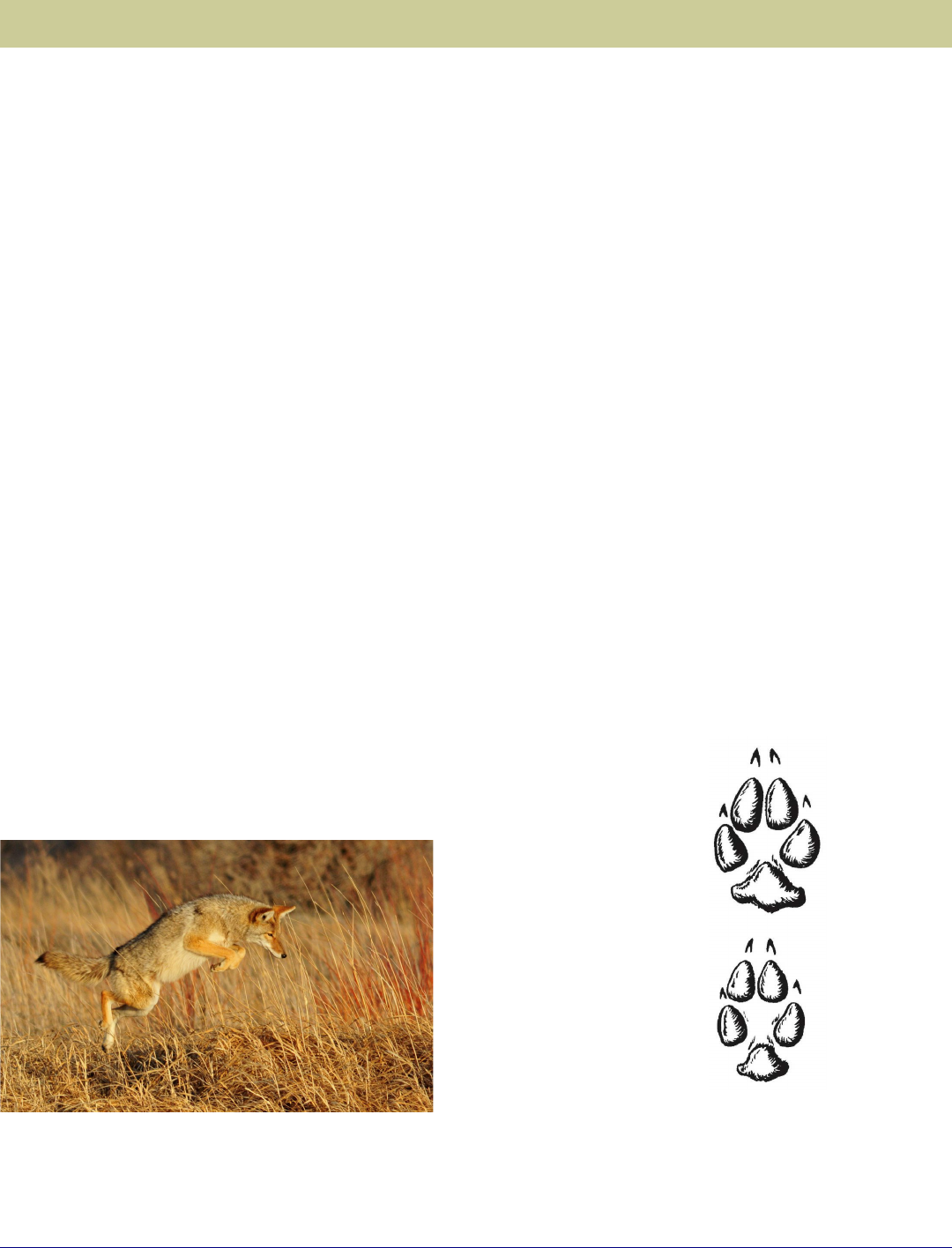
Coyote predation can be costly when it impacts recovery
efforts of highly valued endangered and threatened birds,
mammals, reptiles, amphibians, and insects. Threatened
or endangered species protection programs should
consider coyote predation when these species share the
same habitats, and budget for the necessary costs of
prevention or removal.
Species Overview
Identification
Coyotes belong to the Order Carnivora in the Family
Canidae, along with domestic dogs, wolves, foxes, and
jackals (Figure 19).
Physical Description
Coyotes vary in size. Those from eastern regions of North
America are larger and heavier (30 to 38 lbs /13.6–17.2
kg), than those from the west (20 to 35 lbs /9–15.8 kg).
The genealogy of the eastern coyote includes a
hybridization with wolves and dogs resulting in the slightly
larger size. Adult male coyotes are generally larger than
adult females. Pelt colorations range from near white to
black. Some color phases include red and orange.
Coyotes have excellent hearing, sense of smell, and eyesight.
They have pointed ear tips and a pointed nose. The
distance from the top of a coyote’s back to the bottom of
its chest is equal distance from the bottom of its chest to
the ground. Coyotes differ from wolves in that wolves have
rounded ear tips and a square nose, and have
proportionally much longer legs compared to a coyote.
Coyotes have been measured running at speeds of up to 40
miles per hour (64 kilometers (km) per hour) and can sustain
slower speeds for several miles.
Range
Coyotes occur across most of North America from the edge
of the northern tundra to Central America. In the United
States, all 48 contiguous states and Alaska have coyote
populations, though densities vary with habitat quality.
Tracks
Coyote tracks contain four toes with claws and a heel pad.
The track impression is longer than it is wide. Both front
and rear feet have the same shape, but the rear track may
appear slightly smaller than the front (Figure 20). Coyotes
Page 22
WDM Technical Series─Coyotes
Figure 19. Coyotes are members of the canid family. Figure 20. Coyote tracks. Note the front track
(top)
is larger than the rear
(bottom).
Image not to scale.
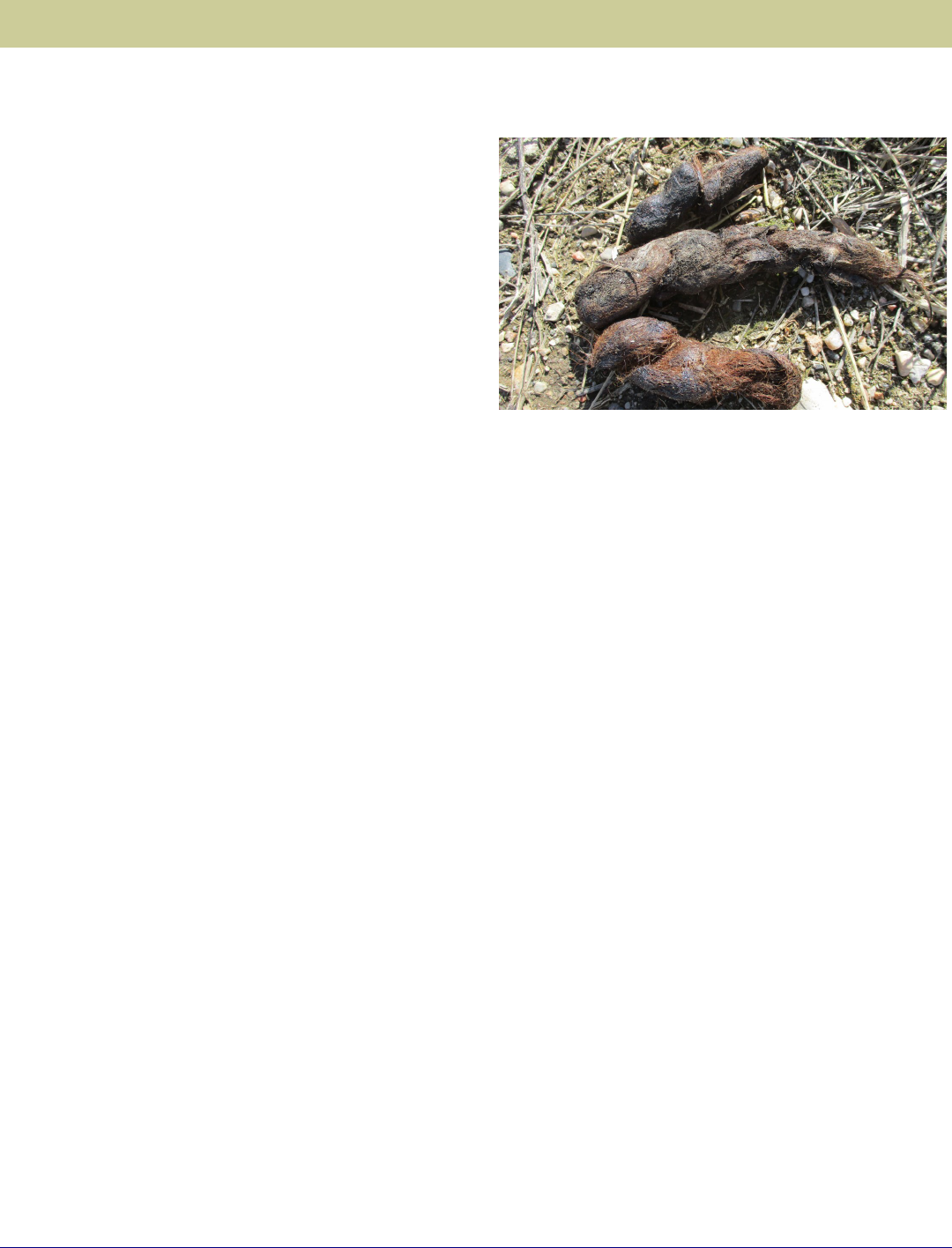
carry their weight forward, resulting in a larger front
track.
Front foot tracks average 2 inches (5 cm) wide by 2.5
inches (6.3 cm) in length. The rear foot track averages
1.5 inches (3.8 cm) wide by 2 inches (5 cm) in length.
Track impressions vary with animal weight and soil or
substrate conditions. It is best to obtain several
observations and measurements over a greater area to
make an accurate identification.
Tracks made by the front feet show the third toenail
(counting from the inside to the outside of the foot)
slightly longer than the others. The heel pad contains
three lobes. The heel pads on the rear feet tend to have
convex center lobes which cause the lobes on either
side to disappear in the track. This knowledge may be
useful in determining a front or rear foot impression.
Tracks in a single file represent a walking gait; tracks in
a two-step (one track partially over another) represent a
side trot; and a track pattern resembling a “T” (where
the back feet surpass the front feet) represent a gallop.
The walking and side trot gaits may measure 17 to 25
inches (43 to 63 cm) between the same foot-track in
that pattern. When observed, the distance between the
left and right tracks (straddle) is approximately 5 inches
(12.7 cm). The track of eastern coyotes may be slightly
larger and the distance between track impressions of a
traveling coyote slightly longer.
Sign
Coyotes will urinate on elevated clumps of grass, dirt,
old carcass parts, small waste grain piles, or other
similar material as a method of communication. These
locations are obvious when snow is present, less when
surface conditions are dry or hard. Look for evidence of
scratch-ups (i.e., surface scratching or kick-ups done by
the rear feet) adjacent or close to where the urine was
deposited. Similarly, scat (feces) may also be found on
gravel roads or trails and at trail junctions. Visiting
coyotes may also leave their urine and scat on top of or
adjacent to previous deposits.
Scat segments (i.e., cords) vary in shape and size
depending on diet and the size of the coyote (Figure 21).
Segments are slightly tapered at the ends and may
measure 2 to 5 inches (5 to 12.7 cm) in length. The cords
may be folded and the last segment to be deposited will be
pointed. Examine fresh segments to determine the diet.
Items that may pass through the coyote’s digestive system
include hair, bone fragments, exoskeletal segments of
insects, fruit pits or seeds, blades of grass, artificial
materials (plastic) or other items. Scat containing
unidentifiable dense black material and a disagreeable
odor is heavy in animal protein, indicating a recent diet of
meat.
Voice and Sounds
Coyotes communicate through a variety of vocalizations. In
a relaxed and safe environment, coyotes will whine and
growl in several low tones which have very different
meanings. Some may serve to gain attention while others
serve to create avoidance. Barking generally serves to gain
attention or announce danger. Howling communicates
location, which sometimes draws others to howl from their
location. Howling can communicate a single coyote
searching for others or may define an occupied home
range. Howling sessions may include a series of barks,
yips, whines, and howls. When this occurs, the listener may
Page 23 U.S. Department of Agriculture
Figure 21. Coyote scat. Note red hair from feeding on a red Angus calf.

be led to believe there are many more coyotes than are
actually present. Two coyotes can easily sound like six. Pup
distress whines and yelps are a typical vocalization for sub-
dominant coyotes when being chased, injured, harassed,
or attacked by others.
Reproduction
Coyotes usually breed in February and March, with gestation
being 60 to 63 days. Females sometimes breed during the
winter following their birth, particularly if food is plentiful.
Females may have been bred by more than one male.
Average litter size is 5 to 7 young. More than one litter may
be found in a single den; at times these may be from females
mated to a single male. Coyotes are capable of hybridizing
with dogs and wolves, but breeding opportunities are rare and
individual species’ behaviors make it difficult.
Adult male and female coyotes provide food to their young for
several weeks. Other adults associated with the denning pair
may also provide food and care to the young.
Juveniles begin emerging from their den by three weeks of
age, and within two months they follow adults to large prey or
carrion. Juveniles are usually weaned by six weeks of age
and will be moved to larger quarters with less structure than
a den hole. The family group usually remains together until
late summer or fall, when juveniles may disperse. Juveniles
may be found in loose family groups until the following
breeding season begins.
Dens
Coyotes prefer a below-ground cavity for a den site. If that
is unavailable, they may resort to any protected area like
brush or rock piles, under or in abandoned buildings,
haystacks, or any similar object that will provide shelter
from the weather and some level of security.
Coyotes may have several den sites, some interconnected.
Coyotes will move to a different den, if circumstances
occur that threaten the safety and security of the den or
young (e.g., infestation of fleas, recent human activity in
the area).
Page 24
WDM Technical Series─Coyotes
Rural den locations are generally located on an elevated
piece of ground, facing south, with water nearby. An
entrance is approximately 12 inches (30 cm) wide. The
opening is generally taller than it is wide. The entrance
may be larger if the den has been used for consecutive
seasons. The depth and cavities within the den site vary
based on the adult’s experience and material in which
the den is created. Den site openings may be littered
with indigestible prey parts, bone fragments, small
skulls, and wings or feathers.
Mortality
Mortality is highest during the first year of a coyote’s life,
and few survive for more than 12 years in the wild. Human
activity is often the greatest single cause of coyote
mortality.
Adult coyotes have few natural predators, but juveniles
are killed or eaten by feral dogs, mountain lions, and
golden eagles. Wolves prey upon coyotes to reduce
competition in overlapping habitats. Coyotes may die
from injuries by bears, lions, and wolverines while
scavenging at kill sites, but are rarely preyed upon in
those situations. Coyotes have been known to feed on
other coyote carcasses during times of severe stress,
such as extremely cold temperatures.
Coyote populations are also impacted by zoonotic
diseases, such as rabies (Lyssavirus), canine parvovirus
(Parvovirinae), heartworm (Dirofilaria immitis), and
canine distemper (Paramyxoviridae). Rabies continues
to be addressed in some regions of the United States by
using treated baits to vaccinate coyotes.
Parasites
Tapeworms (Echinococcosis granulosus) and stomach
roundworms (Toxocara canis) are common in coyotes.
Coyotes host ectoparasites like chewing lice
(Trichodectes canis), ticks (Ixodes dammini,
Dermacentor variabilis, Dermacentor andersoni, and
Rhipicephalus sanguineus), fleas (Ctenocephalides
canis), and mites (Sarcoptes scabiei). Ticks transmit

Lyme’s disease and Rocky Mountain spotted fever; fleas
spread tapeworm (Dipylidium caninum); and mites inflict
sarcoptic mange. Although parasites may not be the direct
cause of death, the effect of parasites on the coyote’s
immune system and overall health or body condition may
be fatal. Hyperthermia, hypothermia, and pneumonia are
common causes of death related to compromised immune
systems due to parasites.
Coyotes can be a definitive host for Neospora caninum
which can cause abortion and neonatal mortality in cattle.
Thick-walled spores called oocysts are passed in coyote
scat and ingested by cattle feeding on infected materials
(e.g., ground feed, hay, stored haylage, and pasture
grasses). Neonatal infection occurs causing abortion or calf
death within the womb. This parasite affects sheep and
dogs in the same manner.
Population Status
Coyote populations vary across the country and are
considered abundant. Coyote densities are highly variable
depending on the time of year, habitat quality, and region.
Habitat
Originally an inhabitant of the open grasslands and prairies
of the western United States and southern Canada, the
coyote has adapted to a wide range of habitat conditions
from southern swamps to northern spruce-fir forests.
Coyotes occur in urban and suburban environments,
including some of the largest cities in North America.
Behavior
Most coyotes are gregarious. When conditions and
individual coyote behavior allows, family groups may
loosely remain together and exhibit social structure. An
alpha pair determines the context of the group and
what individual behaviors are tolerated. The alpha pair
mark their territory by defecating, urinating, or making
scratch-ups, and are most aggressive to intruding
coyotes. Other coyotes within the group may share
these responsibilities and mimic this behavior.
Juvenile coyotes most often show gestures of submission,
such as tucking their tail between their rear legs, turning
their head, lowering eyes, skulking, showing their belly, and
whining when in the company of adults. Aggressive
gestures during adult coyote confrontations include pinned
back ears, showing of teeth, arched back with a stiffened
grotzen, and growling or snarling.
In the spring and summer, most coyotes limit their
movements to a small area due to birthing and rearing of
their young. Individual or unpaired coyotes are not restricted
to such duties and continue roaming as needed during this
time. Coyotes may roam over larger areas in late summer,
fall, and winter. Coyotes follow regular travel corridors and
trails and prefer slight elevations from which to view the
surrounding area.
Primarily nocturnal, coyotes may be active during the day.
They are most active during the hours near sunrise and
sunset. This is especially true during hot summer months and
where there is a lot of human activity. Where there is minimal
human interference and during cool weather, coyotes may be
active throughout the day. Coyotes bed in sheltered areas
and do not generally use dens except when raising young. A
bedded coyote usually has the wind at its back and observes
the area downwind. They may seek shelter underground
during severe weather or when closely pursued. Coyotes are
excellent swimmers and have little difficulty crossing
bodies of water or rivers.
The home range of a coyote is defined as the area it
routinely visits during a 7-day period. Home range size is
heavily dependent upon food and suitable habitat. Coyote
densities are generally higher when food resources are
abundant. Home ranges may be 4 to 15 square miles (6.4
to 16 km
2
). Coyotes may explore and occupy much larger
areas in search of food, water, new home ranges, or during
the breeding season. Home ranges are fluid for most of the
year. Under normal conditions, coyotes are tolerant of each
other and many work to avoid direct confrontation with
others.
A coyote’s territory is defined as the area that is defended
from other coyotes or other animals. Territories become
Page 25 U.S. Department of Agriculture

well defined when pairs are mated, den sites chosen, and
when rearing young. During these times, the size of the
territory is determined by the adult pair’s tolerance for
other coyotes. Offending coyotes are generally discouraged
through vocalizations, body gestures, or being aggressively
run off. The territory is smaller and more closely guarded
when young of the year are within a den site, but becomes
larger as the young grow and venture out with the adults.
Territory size varies and is heavily dependent upon the
available habitat (food, water, shelter, and space). Territory
size may be as small as 0.25 to 0.56 square miles (0.4 to
0.9 km
2
), and as large as 1.2 to 2.9 square miles (1.9 to
4.6 km
2
) in more open areas.
Coyotes that occupy urban and suburban areas are often
less wary of people and may kill and/or eat domestic pets,
and attack people. Coyotes vary their activity based on
human interactions and perceived threat levels. Coyotes
learn from past events that were unpleasant or frightening,
and often avoid such events in the future.
Food Habits
Coyotes are omnivores and opportunists, feeding on a variety
of seasonal offerings—carrion, rodents, rabbits, birds, reptiles,
ungulates (usually fawns), insects, feces, livestock, poultry,
fruits, berries, and other plants and animals. Urban and
suburban dwelling coyotes may also feed on human garbage,
pets, domestic pet food, garden produce, and birdseed.
Coyotes are capable of catching and killing all ages of healthy
domestic livestock but generally take prey that is the easiest
to secure. Prey selection is based on opportunity and a
myriad of behavioral cues. For example, strong, healthy lambs
are often taken from a flock by a coyote even though smaller,
weaker lambs are also present. Stronger lambs may spend
more time on the periphery of the flock and are more active,
making them more prone to attack than weaker lambs that
are at the center of the flock and less active.
Page 26
WDM Technical Series─Coyotes
Legal Status
The legal status of coyotes varies from state to state. In
some states, coyotes are protected except during the
regulated hunting and trapping seasons. Provisions may
exist for landowners or operators to remove coyotes to
resolve predation. In other states, coyotes may be
classified as a predator or as an unprotected species and
may be taken year-round. Check local and state
regulations for information on seasons, bag limits, and
types of capture devices or methods that can be used.

Page 27 U.S. Department of Agriculture
Figure 1. Photo by Kevin Keirn
Figure 2. Photo by National Park Service
Figure 3. Photos by USDA-APHIS-Wildlife Services and USDA Jean Bonhotal
Figure 4, 15, 17, 21, 24, 25, 26, 28. Photos by Rick Tischaefer, USDA-APHIS-Wildlife Services
Figure 5, 6. Graphics from The Handbook: Prevention and Control of Wildlife Damage. Coyotes. By Jeffrey S. Green, F.
Robert Henderson, and Mark D. Collinge. September 1994. University of Nebraska-Lincoln. Page C-55.
Figure 7, 8, 11. Photos by USDA-APHIS-Wildlife Services
Figure 9. Photo by Michael Marlow, USDA-APHIS-Wildlife Services
Figure 10. Photo by Gail Keirn, USDA-APHIS-Wildlife Services
Figure 12. Graphic by the Association of Fish and Wildlife Agencies
Figure 13, 20, 22, 23, 27. Graphics by Joe Goodman in concert with the Association of Fish and Wildlife Agencies
Figure 14. Graphics by Joe Goodman in concert with the Association of Fish and Wildlife Agencies and The Handbook:
Prevention and Control of Wildlife Damage. Coyotes. By Jeffrey S. Green, F. Robert Henderson, and Mark
D. Collinge. September 1994. University of Nebraska-Lincoln. Page C-55.
Figure 16. Graphic by Joe Goodman in concert with the North Dakota Cooperative Fur Harvester Education Program
Figure 18. Graphic by Natalene Cummings in concert with the Association of Fish and Wildlife Agencies
Figure 19. Photo by Tom Koerner, U.S. Fish and Wildlife Service
We thank Stewart Breck, Jeremy Duckwitz, Lauren Mastro, and Nathan Roberts for providing critical reviews of this
manuscript.
Acknowledgements

WDM Technical Series─Coyotes
Page 28
Glossary
Alpha: The highest-ranking individual in a social group.
Other animals in the same social group may exhibit
deference or other species-specific subordinate behavior
towards the alpha or alphas.
Catch Circle: The disturbed area where a captured coyote
is restrained.
Definitive Host: An organism in which a parasite reaches
maturity and reproduces.
Denning: The practice of seeking out the dens of
depredating coyotes and lethally removing the young and
adults.
Drag: A type of anchoring system that allows a trapped
animal to move a short distance and reach cover or
shelter.
Fladry: A simple, nonlethal tool used to prevent livestock
predation. It consists of a line of brightly colored flags hung
at regular intervals along the perimeter of a pasture.
Grotzen: The long guard hairs of the mane and top of the
shoulders.
Homing Behavior: An animal’s ability to return to the
location where it was originally captured following
relocation or translocation.
Necropsy: An animal autopsy.
Novel Stimuli: An exposure to something never before seen
or experienced.
Omnivore: Animal that eats both plants and animals.
Set: Where and how a trap or capture device is placed.
Set Location: The exact spot where a trap or capture device
is placed.
Sign: Items indicating animal presence in an area; may
include tracks, tufts of fur or hair, scat, teeth or claw
marks, etc.
Keywords
Canids, Canis latrans, Coyote, Livestock, Predation
Citation
Tischaefer, R. 2020. Coyotes. Wildlife Damage
Management Technical Series. USDA, APHIS, WS National
Wildlife Research Center. Fort Collins, Colorado. 42p.
Disclaimer
Wildlife can threaten the health and safety of you and
others in the area. Use of damage prevention and control
methods also may pose risks to humans, pets, livestock,
other non-target animals, and the environment. Be aware
of the risks and take steps to reduce or eliminate those
risks.
Some methods mentioned in this document may not be
legal, permitted, or appropriate in your area. Read and
follow all pesticide label recommendations and local
requirements. Check with personnel from your state
wildlife agency and local officials to determine if methods
are acceptable and allowed.
Mention of any products, trademarks, or brand names
does not constitute endorsement, nor does omission
constitute criticism.

Page 29
Resources
American Veterinary Medical Association Guidelines for Euthanasia of Animals. 2020 Edition. American Veterinary Medical
Association. Schaumberg, Illinois. 121 pp.
Association of Fish and Wildlife Agencies. 2006. Best Management Practices for Trapping in the United States –
Introduction. Washington DC: Association of Fish and Wildlife Agencies. 13 pp.
Association of Fish and Wildlife Agencies. 2019. Best Management Practices for Trapping Coyotes in the Eastern United
States. Washington DC: Association of Fish and Wildlife Agencies. 21 pp.
Association of Fish and Wildlife Agencies. 2019. Best Management Practices for Trapping Coyotes in the Western United
States. Washington DC: Association of Fish and Wildlife Agencies. 17 pp.
Bekoff, M. and E.M. Gese. 2003. Coyote (Canis latrans). Pages 467-481 in Wild Mammals of North America: Biology,
Management, and Conservation, 2nd Edition. Edited by G.A. Feidhammer, B.C. Thompson, and J.A. Chapman. John Hopkins
University Press, Baltimore, Maryland.
Breck, S.W., S.A. Poessel, and M.A. Bonnell. 2017. Evaluating lethal and nonlethal management options for urban
coyotes. Human-Wildlife Interactions 11(2):133-145. doi: digitalcommons.usu.edu/hwi/vol11/iss2/4
Bromley, C. and E.M. Gese. 2001. Surgical sterilization as a method of reducing coyote predation on domestic sheep.
Journal of Wildlife Management 65(3):510-519.
Constable, P.D., Hinchcliff, K.W., Done, S.H., and W. Grunberg. 2017. Veterinary Medicine, 11th Edition—A Textbook of
Diseases of Cattle, Horses, Sheep, Pigs, and Goats. Saunders LTD. 2278 pp.
Dolbeer R.A., M.J. Begier, P.R. Miller, J.R. Weller, and A.L Anderson. 2019. Wildlife Strikes to Civil Aircraft in the United
States, 1990–2018. Washington, D.C.: U.S. Department of Transportation, Federal Aviation Administration National Wildlife
Strike Database Serial Report Number 25.
Green, J.S., F.R. Henderson, and M.D. Collinge. September 1994. The Handbook: Prevention and Control of Wildlife
Damage. Coyotes. University of Nebraska–Lincoln. 76 pp.
Halfpenny, J.C. and E.A. Biesiot. 1986. Second Edition. A Field Guide to Mammal Tracking in North America. Johnson
Publishing Company, Boulder, CO. pp 35-40.
Kinka, D. and J.K. Young. 2019. Evaluating domestic sheep survival with different breeds of livestock guardian dogs.
Rangeland Ecology & Management 72(6):923-932. doi: 10.1016/j.rama.2019.07.002
Mason, J.R., J.A. Shivik, and M.W. Fall. 2001. Chemical repellents and other aversive strategies in predation management.
Endangered Species UPDATE 18:175–181.
North American Trapper Education Program. 2019. Association of Fish and Wildlife Agencies. Washington DC. https://
conservationlearning.org
U.S. Department of Agriculture

Page 30
North Dakota Cooperative Fur Harvester Education Brochure. 2013. Cable Devices: Identification, Use, and Removing a
Dog. North Dakota Cooperative Fur Harvester Education Program. United Printing, Bismarck, North Dakota. 2 pp.
North Dakota Cooperative Fur Harvester Education Brochure. 2013. Foothold Traps: Identification, Use, and Removing a
Dog. North Dakota Cooperative Fur Harvester Education Program. United Printing, Bismarck, North Dakota. 2 pp.
North Dakota Cooperative Fur Harvester Education Manual. 2017. Third Edition. North Dakota Cooperative Fur Harvester
Education Program. United Printing, Bismarck, North Dakota. 208 pp.
Seabloom, R.W., J.W. Hoganson, and W.F. Jensen. 2011. Mammals of North Dakota. North Dakota Institute for Regional
Studies. Printed in Canada. pp 117-121.
Shivik, J.A., D.J. Martin, M.J. Pipas, J. Turnam, and T.J. DeLiberto. 2010. Initial comparison: jaws, cables, and cage-
traps to capture coyotes. Wildlife Society Bulletin 33(4):1375-1383.
Texas Health and Human Services Fact Sheet – Oral Rabies Vaccine Program (ORVP). January 24, 2020. 2 pp.
Timm, R.M., C.C. Coolahan, R.O. Baker, and S.F. Beckerman. 2007. Coyotes — Pest Notes. University of California
Publication 74135. 7 pp.
Timm, R.M. and R.O. Baker. 2007. A History of Urban Coyote Problems. Wildlife Damage Management Conferences—
Proceedings 76. 16 pp.
Tischaefer, R. and J. Olson. May 2015. Using Cable Devices in North Dakota. First Edition. North Dakota Cooperative Fur
Harvester Education Program. United Printing, Bismarck, North Dakota. 46 pp.
United States Department of Agriculture Death Loss in U.S. Cattle and Calves Due to Predator and Non-Predator Causes,
2015. December 2017. 85 pp.
United States Department of Agriculture Fact Sheet - The Livestock Protection Collar. May 2010. 3 pp.
United States Department of Agriculture Goat and Kid Predator and Non-Predator Death Loss in the United States, 2015.
April 2017. 73 pp.
United States Department of Agriculture – Oral Rabies Vaccinations. September 23, 2019. 2 pp.
United States Department of Agriculture Sheep and Lamb Predator and Non-Predator Death Loss in the United States,
2015. September 2015. 64 pp.
United States Environmental Protection Agency, Pesticide Product Label, Large Gas Cartridge. Notice of Pesticide
Registration. January 31, 2017. 5 pp.
United States Environmental Protection Agency, Pesticide Product Label, M-44 Cyanide Capsules. Notice of Product
Registration. January 26, 2018. 7 pp.
United States Environmental Protection Agency, Pesticide Product Label, Sodium Fluoroacetate (Compound 1080)
Livestock Protection Collar. Notice of Pesticide Reregistration. March 24, 1998. 52 pp.
WDM Technical Series─Coyotes

Page 31
Young, J.K., S.W. Breck, and E. Hammill. 2019. Interactions with humans shape coyote responses to hazing. Scientific
Reports 9:20046. doi: 10.1038/s41598-019-56524–6
Young, J.K., J. Draper, and S. Breck. 2019. Mind the gap: Experimental tests to improve efficacy of fladry for nonlethal
management of coyotes. Wildlife Society Bulletin 43(2):265-271. doi: 10.1002/wsb.970
Young, J.K., M.J. MacGregor, E.N. Gese, and D.C. Eckery. 2018. Experimental tests of nonsurgical reproductive inhibitors to
prevent coyote reproduction. Human-Wildlife Interactions 12(2):171-185.
U.S. Department of Agriculture

Page 32
Appendix I—Damage Management Methods for Coyotes
Type of Control Available Management Options
Animal Husbandry
• Birthing schedules
• Carcass removal and disposal
• Herders/shepherds/range riders
• Night penning
• Pasture selection
Denning
Removal of adults and young at den sites
Exclusion
• Net wire and electric fencing
• Corrals
Fertility Control
• No fertility control agents available
• Sterilization of alpha pair
Frightening
Devices
• Fladry
• Propane cannons
• Radios and other noise makers
• Scarecrows and moveable human effigies
• Strobe lights
Guarding Animals
Use of livestock protection dogs, donkeys, and other guarding animals
Habitat
Modification
• Eliminate or reduce vegetation in areas that may provide cover or resting habitat for
coyotes
• Contain or bury garbage
• Remove or bury dead livestock
Hazing
Shouting, shaking a tin can full of coins or rocks, stomping feet, waving arms, etc. to scare
away an animal
Repellents
No effective chemical repellents available
Shooting
May include predator-calling, night operations or aerial operations; May require use of non-
toxic/non-lead ammunition; Allowed with proper federal and state permits
Toxicants
• Sodium cyanide/M-44 (EPA Reg. Nos. 56228-15, 35978-1, 35975-2, 39508-1, 33858-2,
and 13808-8; products are all named M-44 Cyanide Capsules); Restricted Use Pesticide
• Sodium fluoroacetate/livestock protection collar (EPA Reg. Nos. 56228-22, 39508-2, and
46779-1; products are all named Sodium Fluoroacetate (Compound 1080) Livestock
Protection Collar); Restricted Use Pesticide
• Large gas cartridges (EPA Reg. Nos. 56228-21 and 56228-62)
Registered pesticides must be used in accordance with label directions. Some pesticides can
only be applied by persons who have been specially trained and certified for their use. Each of the
chemical methods listed above have specific requirements for their handling, transport, storage,
application, and disposal.
Trapping
Foothold and cage traps, cable devices; Allowed with proper federal and state permits

Page 33
Appendix II—Donkeys as Guard Animals
Consider these key points when using a donkey to reduce depredation on sheep or goats:
• Donkeys should be acquired from a trained, reliable, and professional breeder;
• Choose a medium-sized female (jenny) or a gelded male (jack) compatible with the guarded livestock.
Non-castrated jacks are too aggressive and may injure livestock;
• Use only one donkey per group of sheep or goats. The exception may be a jenny with a foal. When two or
more adult donkeys are together or with a horse, they usually stay together, not necessarily near the sheep.
Also avoid using donkeys in adjacent pastures since they may socialize across the fence and ignore the
sheep;
• Allow 4 to 6 weeks for a naive donkey to bond with the sheep. Stronger bonding may occur when a donkey is
raised from birth with sheep or goats;
• Avoid feed or supplements for sheep that contain monensin or lasolacid, as both are poisonous to donkeys;
• Remove the donkey during livestock birthing, particularly if birthing involves confinement. This avoids injuries
to young livestock or disruption of the maternal bond;
• Test a new donkey’s response to canids by challenging it with a dog in a pen or small pasture. Do not use a
donkey that does not show overt aggression to an intruding dog; and
• Use donkeys in smaller (<600 acres/240 hectares), relatively open pastures with no more than 300
livestock. Large pastures with rough terrain and vegetation and widely scattered livestock decrease a
donkey’s effectiveness.

Page 34
Appendix III—Foothold Traps
The following appendix highlights specific techniques related to the use of foothold traps.
Trap Preparation and Maintenance
It is important that foothold traps be clean and in good working condition. Oxidized/rusted foothold traps should be
cleaned with a wire brush to ensure that all parts function properly. Properly tune the foothold trap with 4 lbs (1.8 kg)
of pan tension and a level trap pan. Wash all foothold traps (new or used) in hot, soapy water and rinse clean.
Once dry, begin the process of protecting the steel from oxidation. This is done with commercially manufactured dips
or dyes that not only darken the color of the steel, but retard oxidation. Plan ahead if using petroleum-based dips as
these will need adequate warm weather and time to dry properly.
Once treated, foothold traps may be dipped in hot, melted wax. A properly waxed foothold trap will have a wet looking
appearance. The wax creates a barrier between the treated steel and the dirt used for bedding. If left unwaxed,
moisture can cause the dirt to adhere to the steel, lowering the performance of the foothold trap.
A foothold trap should be tuned, washed, and waxed after making a catch. The struggles of the restrained coyote will
change the original tuning and wear off some, if not all, of the wax needed for a protective barrier. Reusing the same
foothold trap without proper tuning, cleaning, and waxing will result in lower trap performance and success.
Store prepared foothold traps in covered containers to prevent contamination from unnatural materials or odors.
Set Location
Coyotes travel where walking is easy, such as along infrequently used roads or trails. Do not set foothold traps directly
in a trail, but to one side where coyotes may stop, such as on a small rise, near a gate, or where the vegetation
changes. Place the set upwind from the path (or site of coyote activity) so the prevailing wind will carry the scent
across the area of expected coyote activity. Choose a level spot as close as possible to, but not directly on, the
coyote’s likely path. The coyote’s approach should never be over dry leaves, tall grass, stones, sticks, weeds, or
rough ground. Place each set where the coyote will have a clear view as it approaches.
Good locations for a set are often indicated by coyote tracks or scat. The following are good locations in most rural
areas:
• side hills and saddles;
• near isolated land features like bale stacks, rock piles, or cut banks;
• trail junctions, fences, and stream crossings;
• pasture roads, livestock trails, waterways, game trails, and dry or shallow creek beds;
• near stock ponds and beaver dams, field borders or corners, tree groves, and eroded gullies;
• sites near animal carcasses, bone or brush piles; and
• below rim rock ledges or similar protected areas.

Page 35
A Properly Bedded Trap
Foothold traps set for coyotes must be properly bedded and hidden (See next page for step-by-step instructions).
Foothold traps should be level with or slightly below the level of the soil around it. Use a dedicated pair of gloves for
this process and keep them protected from contamination.
Foothold traps also must be concealed to prevent detection. The most common method is to cover them with dry
soil or waxed dirt. The open space underneath the trap pan must remain free of solids. This is achieved with an
under pan material like fiberglass insulation or odorless foam material. These materials fill the void while still
allowing the foothold trap pan to be depressed. An over-pan cover can be made with wax paper or window screen.
Use a dirt sifter to remove small sticks and stones from the dirt used to cover the foothold trap.
Dirt used for covering can be mixed with shaved wax to create a freeze-proof and waterproof foothold trap bedding.
This type of wax can be acquired from reputable trapping supply dealers. Mix dry-sifted dirt with wax pellets or
shavings on sunny hot days. The wax will melt into the warm dirt and bond to the soil particles. Large quantities of
waxed dirt are made using an electric or propane heat source. Wax dirt is stored in covered containers to prevent
contamination until used.
Other inclement weather options for foothold trap bedding and covering include sphagnum peat moss, dry
manure, buckwheat hulls, or finely chopped hay. A disadvantage to these materials is they are attractive to small
rodents. The rodents digging at these materials may cause the foothold trap to become exposed.
A mixture of one-part table salt or calcium chloride with three parts dry soil prevents the soil from freezing over the
foothold trap. When using peat moss or other dry, fluffy material, cover the material with a thin layer of dry soil mixed
with a teaspoon of table salt. This will blend the set with the surrounding soil and prevent the wind from blowing the
light material away.
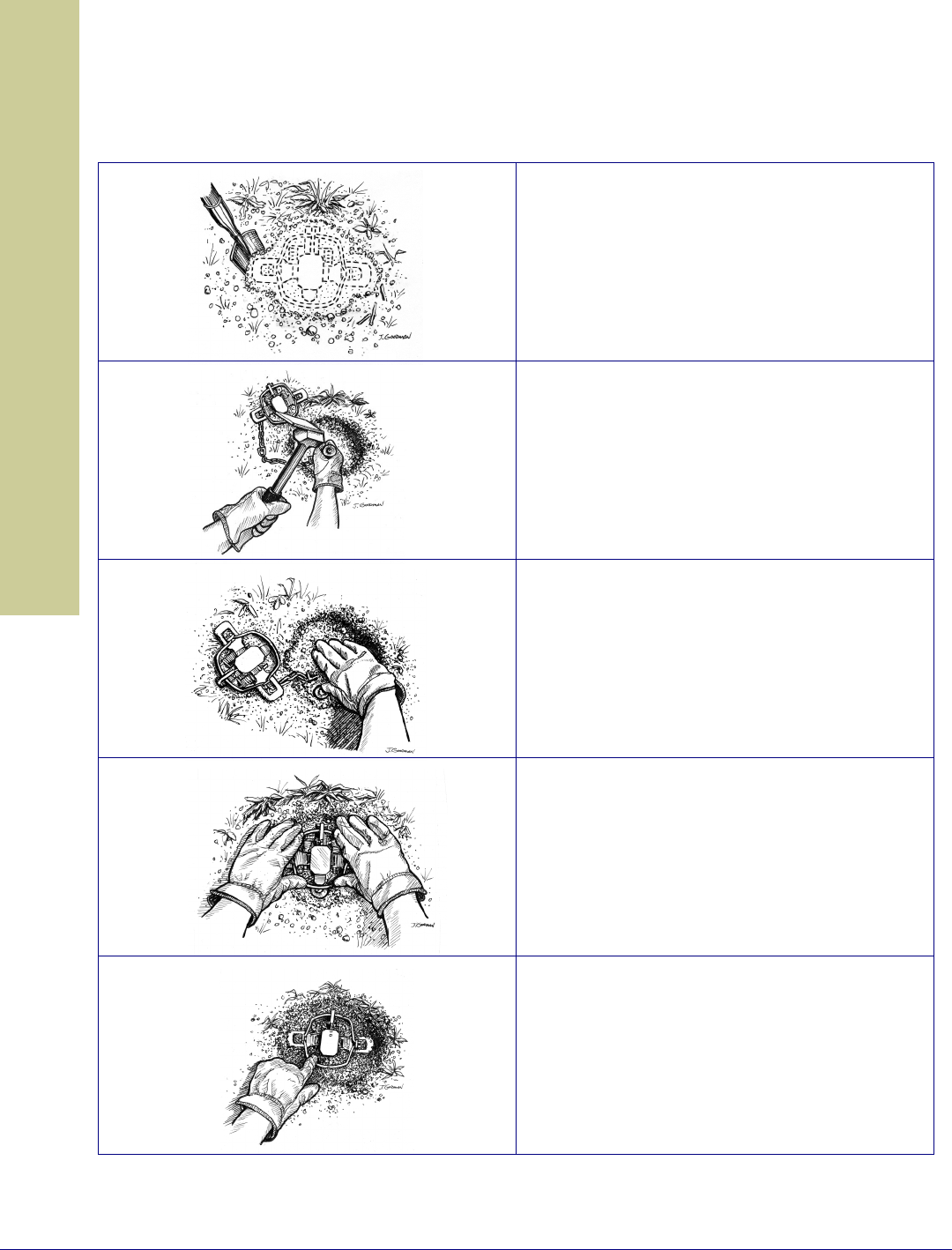
Step 1
Dig a hole slightly larger than the outside profile of the trap.
The depth will depend on the amount of chain to be
concealed under the trap (i.e., the longer the chain, the
deeper the hole). When the set is finished, the top of the
trap should be covered by ⅛ to ½ inch of waxed dirt and the
pan should sit slightly lower than the ground around it.
Step 2
Test the hole to make sure the trap will fit and make
adjustments if needed. Position and drive the stake at the
front of the hole (the side nearest you) where the loose jaw of
the trap can rest on it.
Step 3
Pack the base of the hole with waxed dirt. Place the trap
chain in the trap bed, cover it with waxed dirt and pack it
with a hand or fist. If using an under-pan filler, apply it to the
foothold trap at this time.
Step 4
Place the trap in the trap bed with the loose jaw resting level
on the top of the stake. Twist the trap slightly from side to
side to settle it in the waxed dirt. Pack dirt tightly around the
outside of the trap except for over the spring levers.
Step 5
Use a finger to apply pressure to each jaw and spring lever
(one at a time). If movement is detected, add some waxed
dirt or a small dirt clod underneath to prevent movement.
Page 36
Appendix III—Foothold Traps
continued
Instructions for bedding a foothold trap with waxed dirt during freezing conditions. For a standard set in non-
freezing conditions, ignore waxed dirt references. Graphics by Joe Goodman in concert with the Association of
Fish and Wildlife Agencies.

Step 6
If using a trap pan cover, apply it to the foothold trap at this
time. Sift waxed dirt over the trap until it is nearly level with
the surrounding area.
Step 7
Locate the pan by brushing away some of the waxed dirt.
When found, pack waxed dirt around the outside of the pan
using the back of a hand.
Step 8
If needed, brush or sift a fine layer of dirt over the set to
blend it in with the surroundings.
A side view of a properly bedded foothold trap.
Page 37

Page 38
Guiding a Coyote
Coyotes tend to avoid obstacles and place their feet in bare areas. Use a few strategically placed dirt clods,
sticks, or small rocks at the set to guide the coyote’s foot onto the foothold trap pan. Do not use this method to
the extent that the set looks unnatural. Coyote scat may be strategically placed at a set as an attractant and foot
guide.
Bait, Lure, and Urine
Bait, lure, and urine can be used alone or in combination to attract coyotes to the set and make them stay
longer. The more time a coyote spends at the set, the more likely it will be caught. The choice of bait and its
placement is based on the coyote’s food source and eating habits. Bait can be chunks of meat or fish and
may be fresh, tainted, or in liquid form. Bait must be used carefully to prevent catching non-target wildlife or
domestic animals.
Lures are classified as gland, food, or curiosity attractants. Gland lure appeals to a coyote’s sexual
attraction or territorial instincts. Food lure appeals to their desire to eat. Curiosity lure appeals to a coyote’s
instinct to investigate something unfamiliar. Generally, food lure is the most effective in the early fall; gland
lure becomes more effective in mid-winter and during breeding season; and curiosity lure works well
throughout the year.
Like all canines, coyotes mark their presence by urinating on various objects. Coyote urine is often used to
attract coyotes and works year-round. The sight and smell of urine triggers a curiosity response that may
cause a coyote to investigate the set.
Handle bait, lure, and urine containers with a dedicated pair of gloves. Lure containers and gloves used to
apply them should be kept separate from other trapping equipment to avoid cross contamination.
Types of Foothold Sets
Most sets made with foothold traps are described as either a urine post, flat, or dirt hole set. Other versions
may be a combination of these three basic sets. Regardless of which set type is used, all begin with a
properly bedded foothold trap.
• Urine Post Set: When coyotes urinate, they lower the hind quarters, similar to squatting, or use a slightly
raised leg posture. Urine is usually deposited on some sort of isolated structure, such as woody debris,
a small pile of grain or hay chaff, a dirt mound, or a carcass bone. The urine post set imitates a location
where a coyote has urinated. Begin with a properly bedded foothold trap. Utilize an existing structure (or
add a structure) to serve as the urine post by applying a small amount of coyote urine. Place the urine
post to help guide the coyote’s foot placement.
• Flat Set: The flat set takes advantage of a coyote’s curiosity and urge to investigate smells. Most items
used in this type of set include coyote scat, a dried cow manure patty, a small to medium-sized rock, a
bleached carcass bone or skull, or a small raised clod of dirt and vegetation. The flat set (Figure 22)
Appendix III—Foothold Traps
continued

Page 39
imitates a location where a coyote may linger in casual investigation. Begin with a properly bedded foothold
trap. Move or add natural materials and apply small amounts of bait, lure, or urine to them. Add guides to
help with foot placement.
• Dirt Hole Set: The dirt hole set (Figure 23) takes advantage of a coyote’s need to investigate smells
emanating from a hole in the ground. The dirt hole set imitates an existing small rodent burrow. Begin with
a properly bedded foothold trap. Dig a hole resembling a burrow at a 45-degree angle down and 8 to 10
inches (20 to 25 cm) deep (if soil conditions allow). The diameter of the hole can be as small as ½ inch to
as large as 4 inches (1.2 to 10 cm). Bait is placed in the bottom of the hole and a small wad of vegetation
is added over the bait. Attractants are added outside of the hole to both appeal to the coyote’s senses and
guide its foot placement. The location of the foothold trap pan is placed in anticipation of where the visiting
coyote will step. Note: An existing small rodent burrow or hole may also be used.
Resetting Traps within a Catch Circle
The disturbed area where a trapped coyote is restrained is referred to as the “catch circle.” The odors and
disturbance in a catch circle will often attract other coyotes. Thus, the foothold trap can be replaced, and a new set
made within the catch circle. In some cases, cautious coyotes will approach, but not enter, the catch circle. If sign
indicates that this occurred, make additional sets outside or adjacent to the catch circle.
Human Scent and Coyote Trapping
Coyotes quickly notice human scent. Practice bedding foothold traps frequently to reduce the amount of time spent
making a set in the field. The longer it takes to make a set, the more human scent is left behind. Coyotes have been
known to leave an area after encountering an unfamiliar human scent.
Wet or humid weather causes human scent to remain longer and may make coyotes more difficult to catch with
foothold traps. Wear gloves, wax foothold traps, and take other precautionary measures when setting traps in areas
where people or human activity are limited.
Figure 22. A side view of a flat set with a foothold trap.
Figure 23. A side view of a dirt hole set with a foothold trap.

Page 40
The following appendix highlights specific techniques related to the use of cable devices.
Cable devices should be cleaned and dulled prior to use (Figure 24). The majority of components are made of
metal and the manufacturing process leaves oils and odors on the metal. Some components are galvanized,
and others are bare metal. In either case, metal can shine and must be dulled to avoid detection.
To dull the metal, begin by coiling the cable devices individually and placing them in a kettle. Fill the kettle with
water until the devices are covered. Estimate the amount of water and mix at a ratio of 1 cup baking soda per 1
gallon of water. Mix the baking soda in the water until it is completely dissolved and heat. Once boiling, reduce
the temperature to a low roiling boil for 45 minutes to an hour. Pour off the dirty water and rinse the cable
devices.
The baking soda boil turns the shiny metal a dull gray color. There is no need to color or dye the devices any
further. Besides yellow and violet, a coyote sees the world only in shades of gray. If coloring is desired, match
the color seen from the level of a coyote (24 inches [60 cm] from the ground), not from the height of a standing
person.
Do not use lye, bleach, muriatic acid or other caustic cleaners with cable devices. The cable and aluminum
components will quickly deteriorate with exposure to these chemicals.
Wear gloves when handling and cleaning cable devices. Store cable devices in covered buckets or plastic bags
to avoid contamination. Cable devices do not have to be boiled or treated every season as long as they do not
become contaminated. Inspect each cable device prior to use. The treating process removes any protection the
steel and aluminum parts may have had, resulting in rust or deterioration from environmental conditions over
time.
Appendix IV–Cable Devices
Figure 24. Cable devices can be cleaned and treated with
minimal equipment.
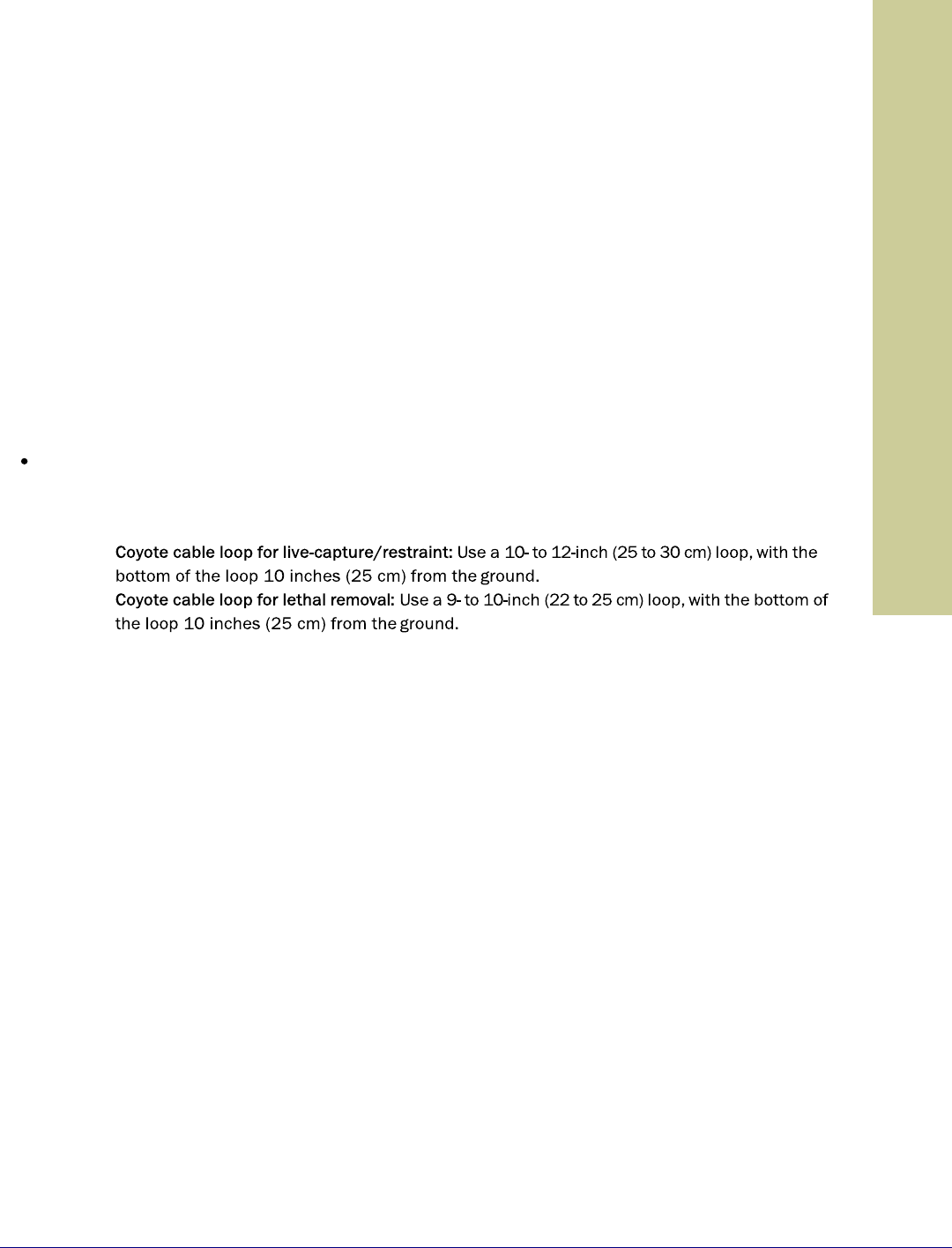
Page 41
Setting Cable Devices
Cable devices are built and include components for specific purposes (live-capture/restraint or lethal) in
specific habitats. Match the device to how it is being used. Different designs include the following:
• Using shorter cables for cattails or tall grass areas, and adding a tangle rod if lethal results are desired;
• Using a lighter breakaway device in areas frequented by non-target animals, such as deer;
• Using medium to long cables in areas with good natural entanglement for lethal results; and
• Checking a device daily when used near people or domestic dogs.
To ensure cable device sets are selective for coyotes, consider the following items.
• Location: Scout, follow tracks, identify the variety of animals in the area, and learn where coyote trails exist.
Avoid setting cable devices in areas with non-target animal traffic.
Loop size and shape: Know the right size loop for coyotes and become proficient at suspending a loop that
size. In some cases, it may be more appropriate to use a smaller diameter loop in narrower trail sets that go
through heavy cover. The following loop sizes represent a top to bottom measurement, not side to side.
•
•
Note: Galvanized Aircraft Cable (GAC) is used to make cable devices. Most often, this cable will not
provide a perfect circular loop. The loop more resembles a teardrop than a circle. A loop resembling a
perfect circle is not required to catch coyotes, nor is a perfect circle naturally observed in the field. The
measurement from a coyote’s chin to the tip of its ears is greater than the measurement from one side
of its head to the other. Teardrop-shaped loops are more appropriate than a perfect circle. It is critical
to ensure the loop is the correct size and height from the ground and centered in the trail.
• Loop height: The loop height is the distance from the bottom of the suspended loop to the ground. As a
coyote passes its head through the loop, the portion of its throat just under the chin should make initial
contact with the bottom of the suspended loop. The coyote’s forward progression will cause the loop to
encircle its neck. When the loop is suspended properly, other smaller non-target animals can easily pass
under the loop (Figure 25).
A Breakaway Component
A breakaway component is designed to fail under an established amount of pressure, causing the complete
disassembly of the cable device loop. A breakaway component allows for the release of larger, non-target
animals accidentally restrained with a cable device.
A breakaway component may be a j-hook, s-hook, or an aluminum release ferrule. Pull testing is done and
weight ratings are established for each type of breakaway. Breakaway component ratings used for coyote cable
devices range from 110 to 350 lbs (86 to 158 kg). These weight ratings correlate to the amount of pressure
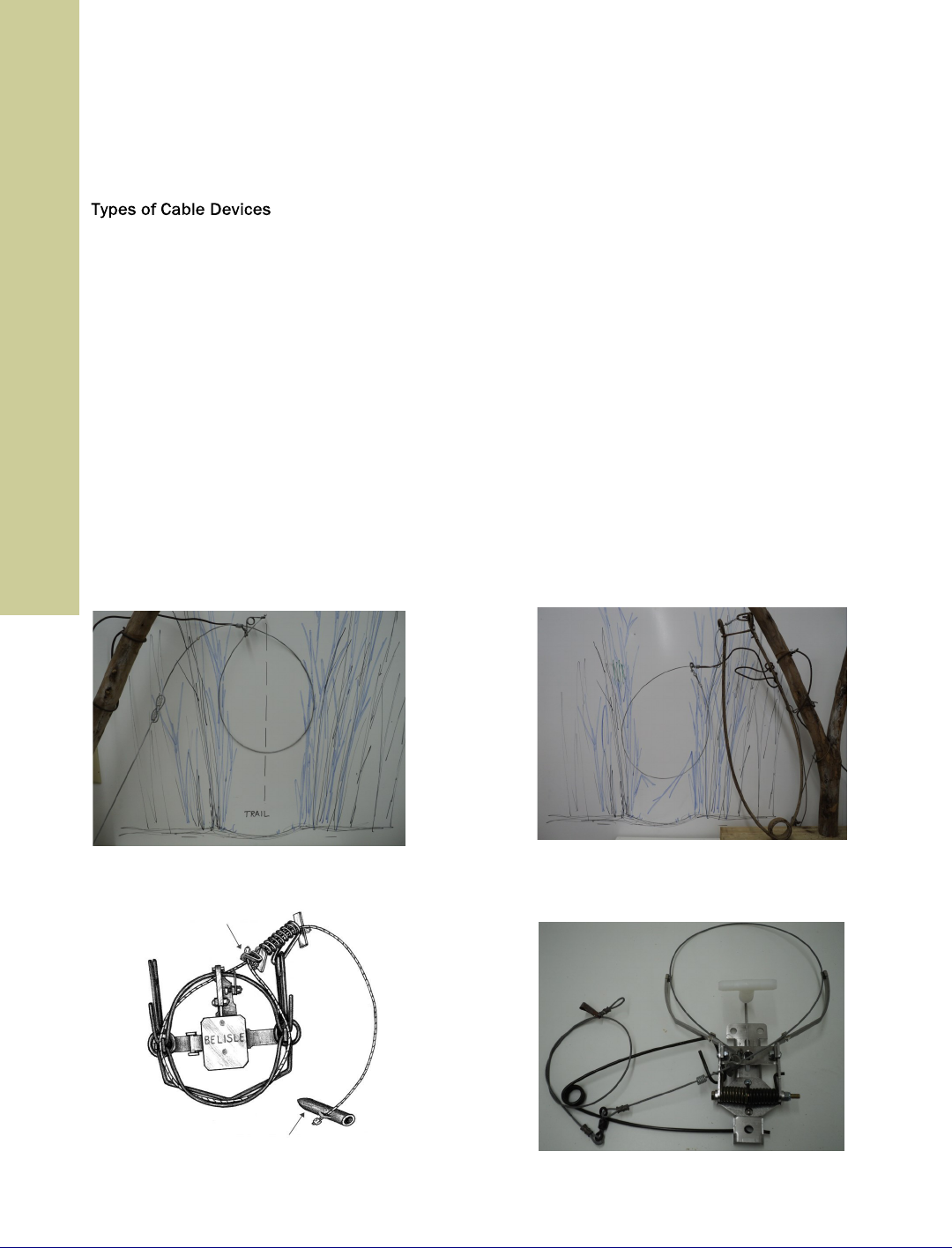
Page 42
required to cause the component to fail. In order to work, a cable device with a breakaway component must
be solidly anchored to an immovable object.
• RAM
®
Power Snare: The RAM power snare is a torsion spring-powered lethal cable device (Figure 26). A
short cable is used to attach the loop to the torsion spring. The torsion spring is set and anchored
parallel to the coyote trail. As the coyote passes its head through the loop, its forward motion closes the
loop around its neck. The continued forward motion allows the torsion spring arm to release and
expand, keeping pressure on the loop around the coyote’s neck and resulting in the animal’s death.
• Belisle
®
Foot Snare: A Belisle foot snare is a torsion spring-powered restraining cable device that works
similar to a foothold trap (Figure 27). When the coyote steps on the pan, the torsion spring arm throws
the cable loop up onto the leg. The coyote is restrained by the cable loop around the foot.
• Collarum
®
: A Collarum is a coil and torsion spring-powered restraining cable device that works similar to
the Belisle foot snare (Figure 28). With a Collarum, the coyote pulls on a baited trigger and the spring
arm throws the cable loop around the head and onto the neck.
Appendix IV–Cable Devices
continued
Figure 25. Center the bottom of the cable loop in the center of the trail. This
set location is for a lethal cable device because the woody rooted vegetation
provides entanglement.
Figure 26. An example of a RAM
®
Power Snare set.
Figure 27. The Belisle
®
foot snare is a torsion spring-powered
foothold restraining cable device.
Figure 28. The Collarum
®
is a coil and torsion spring-powered
restraining cable device.
